HP Memories


I have assembled some short stories about some interesting HP's products, which I think have facts to be revealed about them, that weren't in the popular press. They are a little like Paul Harvey's "The Rest of the Story." In general, these were not HP's most important products in terms of revenue or profits, although some, like the HP 35 hand calculator, were. But they do show the diversity of creative ideas, which surfaced among all those HP individuals, who were looking for customer needs to be solved. And they often reveal some very real human conflicts, in justifying and proceeding with research, when others didn't support it.
In one of our management meetings, Bill Hewlett was discussing how to determine just how much risk we should take, when justifying a new product R&D project. His guidance was that if you didn't have some failures, then you weren't being venturesome enough. I remember him saying that he definitely did want some failures. The other general guidance we used, for some years, was that HP wanted to stay in the technology business, with products adjacent to our normal product line, or which fit into our marketing organization or customer base. This began to change, once the desktop computers and printers and other acquisitions like medical electronics, came along.
In most cases, I've listed a technical reference to the HP Journal issue which featured the product. The HP Journal was the company's pre-eminent technology communications tool, used to explain and promote new products to our mostly-engineer customer audience. This product listing sequence is not in chronological order of introduction, nor even in my view of product importance.
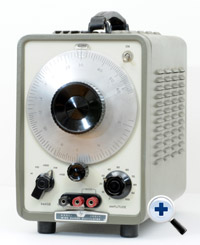 |
The HP 200CD |
HP Journal, Dec, 1952
Everyone knows that Bill Hewlett invented the HP 200A audio oscillator, the instrument that launched the company. But few know that it had an upper frequency limit of only 20 kHz, when first invented. The lab had improved the range up to about 50 kHz, and then ran into circuit parasitic problems, and left it there.
Enter Barney Oliver, returning from years of research at Bell Telephone Labs, in New Jersey. Barney was a classmate of Dave and Bill at Stanford, and was talked into joining HP in the late 1940's. Barney had a way of looking at problems that was unique. His first look at the circuits of the HP 200 convinced him that simply by going to a balanced circuit configuration, he could get well-over a 10 to 1 improvement in the frequency coverage. They tried it, and it worked, to 600 kHz, the first of hundreds of contributions that Barney would make to this company, over a 40 year career.
I recently ran into an interesting retrospective article on the status of HP's main audio oscillator competitor, in 1939. The company was the General Radio Company, of Cambridge, MA. H.H. Scott was later to gain fame and success as a pre-eminent manufacturer of audio systems, and worked at GR before starting his own company.
"In 1937, Scott applied for a pair of patents, covering the application of frequency-selective feedback networks to audio oscillators and amplifiers. One patent covered the resistance-capacitance oscillator, that was destined to completely supercede their older designs, and should have let GR dominate the market for years to come."
"But, for several reasons this did not happen. GR's credo was performance first, price second, sometimes regardless of its customers' wants. In the 1930's, the Beat Frequency Oscillator was a better design, and GR had several models available; Scott, in fact, had helped to design them. In the beat frequency oscillator, two RF signals, one fixed and the other variable, were mixed together to produce the output frequency. This arrangement permitted a wide tuning range, without band-switching. . . . . General Radio now licensed a couple of college kids from California, William Hewlett and David Packard, to use Scott's patent. Hewlett and Packard had been casting about for products that might be manufactured by their newly-formed firm."
"Hewlett was working for his master's degree with a small group of students studying various uses for feedback in amplifiers. Their mentor was the distinguished radio engineer, Frederick Terman. Hewlett's contribution was a feedback oscillator, stabilized by a nonlinear resistance (a tungsten-filament lamp) in one arm of the Wein bridge. Tungsten lamps had been used a year before, in a crystal oscillator by a Bell Labs researcher, and of course, the Wein bridge was not new. But Hewlett was first to bring all elements together in a practical RC circuit. . . ."
"GR belatedly produced an RC oscillator in 1948--their model 1302A. But it was priced at $365. Incidentally, although the unit used a Wein bridge and tungsten lamp, it was not licensed under Hewlett's patent."
From the GR Old Timer's Bulletin, May 1996, Alan Douglas, Pocasset, MA
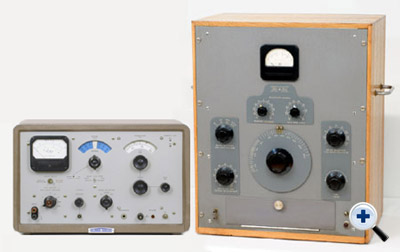 |
HP 302A ---------------------------------------------- HP 300A |
HP 300A HP Journal, August, 1951
HP 302A HP Journal, Sep, 1959
The HP 300A wave analyzer was perhaps the second instrument designed by Bill Hewlett, in 1941. It was a remarkable instrument, in a huge wooden cabinet, almost 3 feet high. It was essentially a tunable audio receiver, with variable IF bandwidth, achieved using control over a regeneration effect, as well as a degeneration effect-presumably using various feedback methods. But it was VERY sophisticated for 1941, when feedback theory was just coming into its own.
I well-remember my Notre Dame engineering laboratories in the late 40's. Standard instructions for preparing for one lab experiment, called for the experiment leader to come into the lab at dawn and turn on the HP 300A so that it could heat up for at least 4 to 5 hours, before any measurements were made. The alignment procedure for the selectivity adjustments in the IF strip bandwidth, and LO were super-critical. The drift of the vacuum tubes would make all data useless if this alignment procedure were not followed rigorously. It took almost two decades to replace the HP 300A. It is an interesting coincidence, that HP's second transistorized product was the HP 302A Audio Wave Analyzer in 1959. That machine was a wonder.
Having used such a problematic instrument like the HP 300A, the HP 302A was nothing less than miraculous. No drift. It had constant tunable selectivity. It even had automatic frequency control, for locking onto a slowly drifting signal.
Dick Rucker relates that Dave Cochran (BART & HP-35 stories) was, in a small way, legendary before he got famous for his HP-35 algorithm work. He worked part-time, nights Dick thought, in the Test Department on HP 300As -- the old original wave analyzer -- while at Stanford, and he tested them faster and better than anybody. And it was reportedly a BEAR to test.
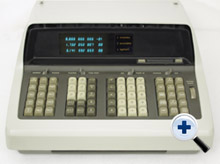 |
The HP 9100A |
HP Journal, Sep, 1968
The first HP desktop computer was introduced in 1968. Barney Oliver credits three people with the combined idea. Tom Osborne, designed a floating point calculator, while with his Logic Design Co, in Atlanta, GA, and brought the idea to HP. Malcolm McMillan had invented a mathematical algorithm and calculator for transcendental functions. Paul Stoft, and his group in HP Labs, saw the future of such a combined machine for engineering and other uses. In that era, we should remember, that clickety-clack teletype terminals were the accepted human interface, for time-share computers.
The HP 2100 mini-computer had been recently launched, with the purpose of controlling one instrument for each of 14 slide-in interface boards on the bottom cardcage. The new industry applications software language was called BASIC. Engineers were just beginning to anticipate the power of distributed computing, using small computers rather than a central big-daddy IBM mainframe. So the world was waiting for a scientific desktop machine.
Al Bagley and Dave Cochran shared with me some insights on the initial history of how HP got into the desktop calculator (HP 9100) business. Al was approached first because his Frequency & Time Division was the only one with substantial digital work going on. He decided that calculators didn't fit his product charter, so he asked Bob Grimm, manager of the Dymec Division, who also declined due to their business overload. All agreed that HP Labs would be the right place, which is where Dave got involved. "1) Tom Osborne talked to Barney, with his balsa wood, floating-point calculator; and some neat logic, like switching the power to turn on a function, but it was only four-function. 2) About the same time Malcolm McMillan spoke to Hewlett about a spin-off of the navigation computer in the B-58 Hustler bomber that could do transcendental functions, but was only fixed point. It was derived from a paper on pseudo division by Meggitt of IBM in 1962." For an interesting insight into how Osborne built a computer without any test equipment, see the Reference Section at the end for his interview with Steve Leibson.
"Barney and Hewlett compared notes, and Barney called a bunch of us together to see if we could marry the two concepts, with Osborne's help. We decided we could put McMillan's algorithms in Osborne's floating-point architecture. Barney asked, 'Who's going to do the algorithms?' I answered, 'What's an algorithm?' Barney said, 'Well Dave, you're going to find out.' Gee, I should have learned about volunteering from my stint in the military."
Cochran observed that he found out in his first investigations, that algorithms go way back. "The word comes from the village of Kurizimi, where there was a 9th century Arab mathematician named Jabar and "al" means "of the." I found some of the early transcendental function routines while doing some prior art work for legal back-grounding, and what we used was described by Henry Briggs in a treatise in Latin in 1624."
Cochran continued, "During the development of the HP 9100 desktop Hewlett had always talked about how it should fit in the typewriter slot in his desk. Well, when we fished the first prototype, someone remembered Hewlett's wishes so we trooped over to his office to check it out. Darn, it didn't fit, but Hewlett was out of town so we called Johnny Harrison at the carpenter shop. By the time Hewlett came back he had a HP 9100 Calculator in his "modified" desk." Bill said, "I knew you guys could do it."
One must also remember that integrated circuits were still a few years from reality. Thus, the Read-Only-Memory (ROM) for the HP 9100A, was constructed out of a l6-layer printed circuit board, with 31,000 bits (diodes) and transistors. The display was a CRT, so that the four-stack registers could all be displayed. And this was HP's first roll-out of reverse-Polish notation (RPN), a preferred number notation for scientific computations. The sales price was a remarkable wonder too, $4900.
The HP 9100A caught the imagination of the engineering community. I believe one of the first units was given to Arthur Clarke, the acclaimed science fiction writer. The project development was done at HP Labs in Palo Alto, and transferred to Loveland Division, Colorado, for production. This product probably became the first HP product to experience large-scale production, compared to the usual HP electronic measuring instruments. And, without question, it launched HP into personal technical computation.
Cochran designed the algorithms, a monstrous job because of the stringent limits on memory size, and the need to make sure that all calculations were accurate over the enormous range of numerical "arguments." Barney later paid tribute to Dave's genius, "I sometimes wonder if Dave realizes what a remarkable job he did? It took several passes. On the first pass, it appeared hopeless to include all functions."
The HP 9100A led directly to the 1972 family of the HP 9810/20/30A programmable calculators (which would then be called desktop computers), which had full HP-IB automation capability.
HP Journal, June, 1972
In a real sense, the idea for the HP 35 handheld calculator came from a number of sources. Certainly the HP 9100A desktop computer, of 1968, showed the popularity and power of a desktop, technical (personal, not depending on a time-shared mainframe) computer in the hands of engineers. Transistorized desktop adding machines were beginning to take the place of the clacking mechanical "comptometers," built by business machine suppliers like Friden Corp., and others. Japan was building desktop calculators for business use, with Nixie tubes for display. Light-emitting-diode numeric displays had barely been invented.
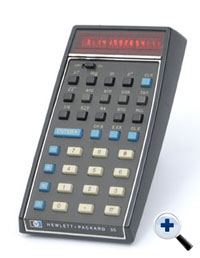 |
The HP-35 |
At the HPA (components) Division, in early 1970, we had just concluded technical negotiations, for supplying keyboard and digital display light-emitting-diodes (LEDS), with a company called Unidynamics of Phoenix, AZ. And yet, after some months of research and production planning, the company, a division of Universal Match Corp., had decided not to proceed toward building a commercial pocket calculator. The main reason was that their core business was production of super-high-tech electronic sub-assemblies for atomic weapons. Their management had concluded that they should not move into the purely-commercial sector.
But, in retrospect, they had the hand calculator product concept, dead on. They had envisioned a handheld calculator, the size of a king-size pack of cigarettes. It had a 6-digit display, mounted horizontally, and four functions of add, subtract, multiply and divide (what we termed a four-banger). Further, they ingeniously had planned two or four more math functions, to be built into the ROM. These had keys that were to be covered up in the first models, but which could be uncovered, as needed, to confront competition, without having to re-design anything inside, merely put a new faceplate on the front.
The reason Unidynamics had come to HPA, was that we had a first-class ceramic facility for building photo-conductors. Photo-conductors were used for the electronic counters, built by the Santa Clara Division, to decode the BCD logic of counting circuits, into the 10-line code needed to drive NIXIE numeric display indicators. Unidynamics envisioned the need for a cheap keyboard, while at the same time, they needed long-life reliability. A photo-conductor keyboard, with no moving parts, seemed ideal.
Their idea was to use a photo-conductor resistive element at each key location. They had built prototypes, which demonstrated that when a finger was pressed into a shaped depression "key," the photo-resistance would change by about 1 million to 1. They had tested pulse-shaping processing circuitry, to eliminate false key inputs, caused, for example, by shadows of moving fingers across the panel, or variations in ambient lighting.
Unidynamics had done their homework. They had hired an experienced consumer-marketing man from 3M Corporation, who became their V.P. of Marketing. He had lined up international distribution for the product to the tune of 10,000 units per month. The price was to be $200, at the time that Japan's Sanyo Corp. was selling a calculator that was the size of a small cigar box for $400. Japan's Canon was moving to a "pocket" calculator, but it had to be a coat pocket because it was the size of a small book. Their price was projected to be about $250.
In other ways, too, Unidynamics was ahead of their time. They envisioned 4 integrated circuits mounted on the rear of the ceramic "mother-board" which carried the key photo-resistors and display on the front. Production would be so certain, that they planned no re-work, because of the expense, and therefore, would simply throw away bad units.
George Klock was project leader, and visited a number of times, along with Philip Tai, who was project engineer. Naturally, as soon as we in the LED group heard about this large project for keyboards, we immediately began our campaign to change their plan, for displays, to LEDs. We proposed either monolithic numeric chips (later used in the HP 35), or an abbreviated 3 x 5 dot matrix. That deal looked like a huge amount of business. They bought into the LED idea, and there were more visits with Tai, to work out the "LED strobing" technique, which we were just perfecting for use in HP 5300 portable counters.
Suddenly, and without warning, Unidynamics called us with the information that they were suspending their project. Amazing. They had the product concept in their grasp. They were about a year ahead of the market. They would have blown the market away. That year, 1970, Japan built about 150,000 total calculators, desktops, "portables" and "handhelds." The 10,000 per month sales estimate of Klock, for $200 units, was probably low by a factor of 5 or10.
Once we had confirmed that the project was clearly cancelled, we felt we were released from our self-imposed HPA rules, about revealing any sales or technical details to other HP entities. We always held such information strictly confidential during our contract periods. In the components business, such technical and business details were sacrosanct. If another HP entity should discover any such details about a competitor who was our customer, we would lose all our credibility.
I then fed back to HP Labs, an overview of the proposed Unidynamics calculator. My memo below mentions that I had just read a speech transcript, by President John Young, that the present HP technology would now permit HP to put the ROM of the HP 9100A desktop calculator into four chips of integrated circuits. That was amazingly close to the Unidynamics four chips, although the HP chips were a full engineering algorithm set. Talk about serendipity.
January 27, 1970 From: John Minck To:
Subject: ELECTRONIC SLIDE RULE Marco, I thought I would pass along a little information for what it's worth in considering a small, portable pocket slide rule or pocket calculator for HP. We've had some recent negotiations with a U.S. company regarding both a digital display and a photoconductor keyboard application that looks like very large numbers. These people are talking about 10,000 units per month, minimum, with the possibilities for two or three times that in a few years. While the particular company's name involved is not too significant, (in fact we probably shouldn't talk about them by name, since they have given us some information that was relatively private) I do think the overall market data and some of the particular components that we have are things that Hewlett Packard should consider. The particular product envisioned would be about the size of a pack of filter cigarettes, turned sideways, with an 8 or 10 digit light emitting diode cluster in the upper left hand corner. These would be about 0.1" in height and meant for viewing within arm's length. The keyboard would be
made up out of a photoconductor matrix for which HPA has already furnished samples. The computation will be done by a few, and I'm not sure how many, MOS integrated circuit chips done with LSI. I'm not sure who is doing their design but I do think that TI is involved. There are the normal numeral entry keys as well as a series of functional keys on the right hand side. We know nothing about the particular functions involved. These people have already lined up an international distributor who has guaranteed to take 10,000 units per month and the proposed selling price is in the $300 range. Although these particular people are neophytes in the calculator business, they do plan to get knowledgeable people in their production and it appears that they will be going toward some state of the art interconnection techniques so that they can do assembly at very low cost. They would plan to have very few rejects at the end and would essentially do no testing, but instead would just scrap the completed package if it doesn't work. That's fairly revolutionary by itself. They might be able to make it work. The main reason I'm writing however, is to inform you of several specific HPA components that might be well-suited to getting Hewlett Packard started on some kind of a project like this. The first of these is a multiple cluster, strobed array, built out of 7 segment numerals, which we plan to have ready in about August of 1970. The product ideal is to "monolithicly" produce the characters about .1" high and arrange them so that they can be strobed or scanned horizontally. We plan to produce these in various length, specialized clusters so they can be used for such things as pocket calculators, portable thermometers and a wide range of other numeric-only readouts. There are also some interesting possibilities of making characters even smaller than 0.1" and using plastic magnifiers of various types so we can get the power drain down even more. Number two component is a photoconductor array that serves as a keyboard input. This is presently being made in John Nebozuk's area and has been specifically selected for the other company's calculator. They looked through a whole series of different keyboard entry ideas and rejected a lot of them because of contact bounce, reliability and just plain cost. It turns out that they have done a substantial amount of work in adapting the HPA photoconductor to use as a keyboard. I think this is where Hewlett Packard needs to find some division with a keyboard need to pick up the present component. The other company puts a plastic mask over the top with holes cut in it about the size of thumbtacks that are appropriately shaped and spaced off of the photoconductor element. The finger that is tapped across the keyboard, much like an adding machine, will go through the pulse shaping circuitry in the right fashion to energize the integrated circuit drive. On the other hand, fingers just moved across the keyboard in front of a bright light or placed gently on the "key" do not have the right closing rate to cause false entries. According to the engineers, one of the main reasons that photoconductors are quite good, is because they have a very wide range of resistance change, approximately one million. They have designed their key covers and shaping circuitry such that a substantially less change of light causes the triggering. That allows them to work from a very low level illuminated room out into direct sun light without having false triggers. I'm particularly excited about this keyboard because it could represent an important reliable component for Hewlett Packard Company and all the variety of keyboard inputs that we are ultimately going to have to have. I would like to find some project that could develop some further human factors work on the key entry. It would also seem to be important to have some sort of audible mechanical feedback to tell the person that he has made an entry. In the case of a calculator, however, it appears that entering data onto the little light emitting display itself becomes the assurance element. When John Young recently mentioned that you had been able to put the entire 9100 onto four MOS chips, it really got me to thinking that an exciting product could be put together from that technology and a couple of display and key entry technologies. A pocket calculator that can do slide rule functions and some additional arithmetic functions and ought to be worth $500 to many technical people. I hope that sometime when you're in the area you might be able to stop by and perhaps we could discuss it in more detail. In any event, I'd appreciate knowing your thoughts on this general market area, and specifically whether light emitting displays and other keyboard elements might have some place in your product plans. JLM:lb CC:
John Minck
|
By that time, our HPA monolithic display chip technology could present a numeric digit, 1/10 inch high, and we could build them reliably. The HP 9100A project team had been pretty-well held together after transfer of the project to production to Loveland. Engineering for the HP 35 got rolling strongly in 1970, encouraged by both Bill Hewlett and Barney Oliver, who became the cheerleaders.
Think about the possibilities. With the ability to create dozens of calculation functions, the team leaned towards Electrical Engineering functions. 35 keys maximum resulted from a product design mandate, that the calculator must slide into Bill Hewlett's shirt pocket. But the power of the machine called for up to 15 digits of numeric display. Barney was leaning toward liquid crystal displays (LCDs), but we, in HPA's LED department were pressing for LEDs, naturally. LCDs were dramatically cheaper, and only for the fact that LCD technology couldn't put 15 digits side by side, did we get the nod on the LED display decision.
In the meantime, we, at HPA, had perfected the use of a simple spherical plastic lens to magnify the 0.10-inch high character. It caused a minor reading drawback, which we called the egg-crate effect. This meant that the user had to place their eye more or less directly in front of the numbers. Otherwise the display would look like the numbers were down inside the partitions of an egg carton. But the fact that a 1/10th inch monolithic number only used about half the drive power as a 1/8th inch high unit, the designers preferred more battery life to larger numbers. It was still a hit, and never, ever, mentioned as a drawback.
In retrospect, the LED decision was very fortunate, for although the LCD technology had been around for 50 years, they were notoriously unreliable during those years. A LCD display set could develop an "infection," on one corner, and it would creep across the whole window, and you'd be out of the display business. Infection is the right word, since LCDs are organic materials. Now, 20-30 years later, things are different, and LCDs are everywhere.
Tom Whitney, HP 35 project leader, decided they could pay $1.05 for each monolithic digit. Our HPA production costs, at the time, showed that we should sell them internally for about $5.00 each. So we figured that with Bill Hewlett behind this project, so strongly, now was the time for a gigantic leap ahead in HPA's LED manufacturing automation.
Our team then developed a Gallium-Arsenide-Phosphide process lab expansion plan, which promised to be the biggest thing we had ever done. Until that time, we would slave over a $30K process machinery capital investment proposal. The proposal might run 20 pages, and still not be accepted. These equipments weren't cheap. Epitaxial reactors for growing layers of semiconductor atoms, diffusion furnaces, saws, polishers, dicers, thin-film deposition, photo-resist stations, automated probing stations, ran to tens of thousands of dollars. Our plan for ramping up calculator digits looked like about $550K.
Sales projections for the HP 35 were interesting. With the outside market, in 1972, expecting to feature four-function machines at around $200 to 250, no one really was confident about how many people would plunk down $495 (the first price proposed for the HP 35) for a pocket slide-rule. Even at $395, the final introduction price, I recall the sales estimate as 500 per month and going to 1000 per month, on the outside.
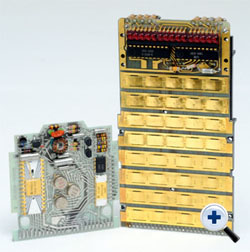 |
The HP 35 Printed-Circuit Boards, showing the click-key assembly and the LED display row. |
At the LED department, fortunately, Marketing Manager Milt Liebhaber and Rick Kniss, the LED Product Marketing Engineer, had big plans for outside sales of LED digits, that would leverage on the production of the HP 35. We were sitting around one evening with the thick equipment proposal in front of a group of us, presided over by Division Manager Dave Weindorf. After much discussion, Dave suddenly said, "What the hell, let's make it a proposal for a cool three-quarters million".
So we corrected the equipment lists, to get up to $750K, and went up to see Bill Hewlett the next day. We had our arguments well honed and practiced, for proving the need for supporting the all-important HP 35, with incidental outside sales thrown in. After 5 minutes of preliminaries, presenting our executive summary, Bill stopped us, saying, "I've got another meeting, so is there anything else important, that I should know? If not, let's go with it." We almost wanted to say, "But, Bill, we have all this backup argument material, don't you want to hear it?" It was by far the easiest project I have ever seen sold. But it shows the magic of that calculator project in those days.
In retrospect, it was extremely lucky we sandbagged Bill on the materials processing lab for GaAsP. The 500-1000 per month forecast for the HP 35 was wildly wrong, on the low side. Sales went through 10,000 per month, climbing almost straight up. The reasons, of course, are clear with hindsight. The price was a stroke of genius, because the $395 was easily within the reach of every engineer, not just managers. It was not only a prestigious personal possession, but an amazing drudgery beater. It made better engineers, and it made them faster and more efficient.
Meantime, Tom Whitney was having trouble freezing the keyboard design. With literally hundreds of different key functions one could choose, Barney and Bill were continually coming up with better ideas for key functions and layout. Tom had finally arrived at a crucial date, where the IC ROM masks had to be frozen, to be sent to the IC vendors, and be ready for production dates. Tom sent out a memo to all the algorithm people, Dave Cochran, Bill and Barney. The notice stated that he had reserved the meeting room for as long as it took, that day, to freeze the keyboard functions to everyone's satisfaction. At the end of the meeting, all would sign the final keyboard paper, and he would walk out to call the IC manufacturer with the final specs.
The meeting did take a long time, hours. Back and forth, since this was to be the way the calculator would not only look, but perform. To all those engineers, with those options, it must have been excruciating. At the end of a long period, they agreed, and all signed the penciled-in key nomenclature. Tom thankfully walked back to his office, ready to prepare the material to call the IC supplier the next morning, and the phone was ringing. It was Barney. "I've got another idea." "Too late," said Tom, and he called Bill to see if he could make it stick. Bill said to go with the agreed paper.
The HP 35 introduction, in 1972, couldn't have come at a better economic time for HP. The US business economy was in the doldrums, and this high-profit product energized our balance sheet. The thing we had failed to comprehend, was that engineers would find this personal calculation powerhouse indispensible. They would not rely on their companies buying them, instead, parting with their own money to posses one.
Tom Osborne, the project consultant, told me of an occasion of his visiting the Smithsonian Institution in Washington, DC. He went to see the display of the original ENIAC computer, used in the WWII project for artillery-table computations. At the time, he was carrying the HP 35. He told me he was suddenly struck with the realization that, inside his coat pocket, in the HP 35, was more computing power than this entire roomful of equipment racks. The racks held 18,000 vacuum tubes, that burned out at the rate of about 5 per hour. Of course, it was an unfair technology comparison that spanned 2.5 dramatic technology decades. Tom was humbled to realize that his little baby computer in his pocket was more powerful, and certainly more reliable, than that monster system.
Field engineers found clever ways to sell HP 35s. Jim Bunn of the Las Cruces, NM sales office called on the U.S. Army's White Sands Proving Ground. He discovered that, while military operations sometimes ran out of expense or capital budgets, there was often a lot of training budget left, near the end of their fiscal year. Jim cleverly arranged to put on a training seminar for "Reverse-Polish-Notation Scientific Computers." It was an honest description for the HP 35. The special HP training course cost was set at $500, and included an HP 35, as a class "training tool," which the student was allowed to keep.
Dave Cochran remembers, "Soon after that (the success of the HP 9100A), Hewlett began pestering me about putting the 9100 in his shirt pocket. Even several years later the right architecture for the state of IC miniaturization just wasn't there to accommodate what we wanted to do. I was even thinking of getting hold of Hewlett's tailor to get his pockets made bigger."
"I stumbled across an architecture during a visit to Fairchild that made it all gel. It contained a 'racetrack' register memory that greatly reduced the access and interconnection requirements and was excellently suited for the 'CORDIC' algorithm to calculate the transcendental functions."
"Fairchild was trying to make a twenty-digit four-function calculator but hadn't applied for a patent. In the next few weeks I roughed out architecture for arithmetic and logic chip, control and timing chip, register chip and ROM structure. I also devised an instruction set and flow-charted a few functions including subroutine calls."
"Excitedly, I went running off to Hewlett, 'Look, I can do it now, if you give me the million dollars for development.' Hewlett, who sometimes was unsure of himself without Packard who was at the Pentagon, said, 'Wait a minute, I want SRI to do a market analysis on this.' Four months later SRI said that if it was four-function it should be under $100 but they could not supply a recommendation for a pocket scientific calculator because there had never been one."
"While waiting for Hewlett's decision we still went ahead on all fronts, I even devised a sampling scheme for the LED display that Minck mentioned that had the added benefit that it used only 10% of the calculated power due to the 'super linearity' of LEDs of the day. If you strobed each segment at a 1% duty cycle the current only went up by a factor of 10 for the same light output. I remember thinking that it may affect the reliability so I ran a sample at 0.1% duty cycle and compared the light output after six months, luckily it was the same."
"I remember when Fred Terman got his sample HP 35, we made about six prototypes, he just couldn't believe it, kept looking for the cable. Louie Alvarez called it the 'eighth wonder of the world.' Having an HP 35 in the early days meant you could attract attention without having to know how to play the piano, but mostly you got all the men hanging around you at cocktail parties."
The inherent power of these hand calculators was contained in their algorithms. These abstract mathematical flowcharts are really the processes the machine goes through, to solve the transcendental and other complex equations. Some people's brains are born with the power to envision these algorithms, in their total flow pattern, and somehow see through their complexity. One of these men was Dave Cochran. He created the heart of the HP 35, and probably has not gotten near enough credit for it in the outside world.
Dave told me that as other competitors came into the scientific calculator market, notably Bowmar and Texas Instruments, that he came to meet the algorithm inventors of those companies. They tended to be the same kind of genius-type people, clever and crafty. In one sense, it was a reputation thing, with each conceding points, if a particularly clever algorithm was being tested and qualified. But in other ways, these geniuses were playing other games. It became a kind of chess game. They might tell about a new algorithm idea, but might salt-in traps and false leads, to put the other company on the wrong track for a time. Naturally, there were advantages to be gained in talking together since, often, it established industry standards and processes, and it was such an arcane art. Yet, all information had to be taken with huge caution. Did we gain more than we lost? Knowing Cochran, I suspect we gained a lot more.
The HP 35 was probably HP's number one product winner of its 6 business decades. It captivated our technical customers. It raised HP's already high prestige. It brought untold computing power to the fingertips of the common engineer, and they worshiped HP for the innovation. Finally, it sparked a long succession of more and more powerful machines, the magnetic-strip programmable HP 65, financial versions, and many more.
I personally believe that the HP 35 changed our HP history. It most certainly launched HP into the "consumer" market, even though this particular product had a professional (engineering/consumer) focus. HP later introduced other powerful consumer machines, some years before competitive $10 units began showing up in drugstores. The line of successful pocket calculators also reinforced HP's dominance in desktop computer technologies, such as the follow-on HP 9810 and 9830, and later the highly-programmable HP 9826 and 9836.
In looking back on those heady days, I can recall one evening in the small office area we all shared, talking about how the power of personal calculators would change our world. We were then immersed in a manufacturing technology where semiconductor packaging still required careful handling. IC chips were contained in separate plastic in-line packages and those dozen components had to be inserted into printed circuit boards for all the hundreds of interconnecting wires.
Our conversation got around to real visionary stuff, like attaching the IC chips directly to the PC board and bonding to the board. Then you could just squirt out a drop of plastic silicone to protect the whole thing from humidity, and sell the whole calculator in a drug store for $10. Then we all laughed at our folly! However, knowing what I knew about the rapid decline in anything made of semiconductors, I did have the feeling that it just might happen someday.
Finally, there was a fascinating postscript to the Unidynamics story. In the 1980's, long after the 1970 negotiations for LEDs. I was back at Bldg 5, working on MW products at SPD Marcom. In those days, all customer inquiries sent to corporate headquarters in Bldg 3, were parceled out and sent to the appropriate division marketing people to answer as they had time. It was probably the late 80's, when a letter arrived from Australia, a teacher in a tech school had written to HP for some technical or product posters for his classrooms. The teacher's name was George Klock.
I gathered together a bunch of HP product posters and banners plus a frequency allocation chart and some other generic posters and sent them along. I also sent a note telling that years before I had known a George Klock from Unidynamics, and wondered if that were he? It was. After the calculator project was shut down, he migrated to Australia to start life anew, and ended up teaching, which he loved. Now, imagine the tiny statistical chance that I would pick up that particular letter out of a pile that just happened to be sent to our division. Another stunning coincidence of my life.
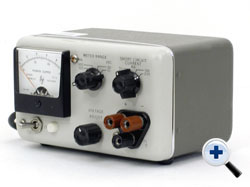 |
The HP 721A |
HP Journal, May, 1958
The honor for first transistorized product for HP, was the HP 721A Power Supply. It was a simple concept, a 30 vdc range and 150 ma capacity, with a clever current-limit feature. That safety feature was so critical to a generation of engineers that were just learning that transistors were not as forgiving to electric shorts and other mistakes as tubes. If a test circuit was misapplied, the HP 721A power supply would simply cut off its current to a safe level, that the engineer could dial in. I remember being surprised how many thousands of engineers would buy the product at an introduction price of $145. For only 150 milliamps. But such was the rush to semiconductors of the day.
The circuit design was invented by Malcolm McWhorter and George Barr, both Stanford University professors. They went on to found the Vidar Company, using some of the royalties that were generated from this simple power supply idea. Malcolm McWhorter was my digital circuits professor at Stanford. In 1952, in my undergraduate days at Notre Dame, the transistor was described in mimeographed notes, having just been invented in 1948. So, I really needed to get re-treaded on digital circuit theory, when I hit my graduate school study at Stanford. McWhorter's classroom style was magnificent, and he was perhaps my best technical professor. His explanations and circuit models remain with me today, although I often have to admit that I never really did an honest day of engineering in my life, preferring and enjoying marketing so much more.
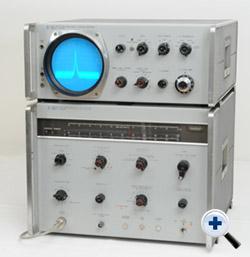 |
The HP 8551/851A |
As mentioned earlier, this product put HP into a brand new microwave market area. We had been known for signal generators, power meters and swept-frequency testing before that. But the market for spectrum analyzers was owned by Polarad with about $5 million annual revenue and Panoramic Corp., at about $2 million. Spectrum analyzers had been designed for use with radars during WWII, and Polarad, located in New York City, had been a contractor for the government. Basically, a spectrum analyzer is a tuned super-heterodyne radio, with a swept-frequency or "panoramic" display, signal power plotted vertically against a horizontal scale of frequency.
HP launched into spectrum analyzers, partly driven by pressure from our Field Sales Engineers, who were looking for a new market area. The Polarad analyzers were mostly single-octave-band, hand-tunable klystrons, used as the first local oscillator. The sweeping 2nd local oscillator (LO) provided the 100 MHz sweep width (dispersion, in the jargon of the day). The Panoramic Company, also on Long Island, was soon building a multi-band unit, capable of 2 to 12 GHz, which down-converted using harmonics of the 1 st LO.
The project engineer assigned to the HP analyzer was Art Fong, who had been recruited from the WWII MIT Radiation Lab. His experience there had involved building signal generators and specialized spectrum analyzers, including waveguide components. By designing a sweeping FIRST local oscillator, using a backward-wave-oscillator (BWO) for the source, it was possible to provide a remarkable 2000 MHz of sweep width. The key technology, needed in the use of the BWO, was the breakthrough use of a tracking, phase-locked, low-noise-VHF sweeping oscillator. The ability to track while phase-locked, quieted the phase-noise of the BWO tube, when in the narrow band sweep mode.
The HP unit was conceived to have a number of significantly higher-performance features, far wider sweeps, an honest and calibrated 60 dB of amplitude range. Yet, it was thus destined to cost much more. In my original market research, I had found that most customers would have been happy to have the same performance as Polarad, but just have a product brand from HP, with HP workmanship, features and reliability. But when we plotted the price-volume curves, the tail of the curve, as usual with most HP products, stretched flat, far to the right. Which simply meant that there would be considerable demand, even with prices that might be twice the available products, or in this case, some real demand even at $15,000.
The HP 8551A Spectrum Analyzer was first demonstrated, privately, to customers during the 1963 IEEE show in New York. Project Engineers Art Fong, Harley Halverson (HP851 display), George Jung (HP 8551 RF section), and others, had finished a prototype, to bring to a hotel room, for showing to VIP customers. The unit was mounted on a draped table, but under the drape was a massive fan, blowing air up through a laundry dryer hose umbilical, to keep the parts cool. It took a lot of air to cool the high-voltage power supply, needed to run the backward-wave-oscillator, requiring 2400 volts.
Actually, the price was approved in a hotel room, too, a year later, just prior to the 1964 New York IEEE show. Marketing V.P. Noel Eldred, Division Manager Bruce Wholey and I met to agree on the price. I presented a price-volume plot to guide us on the product price. Largely an estimate, it showed that at prices of $5K, where there were competitive offerings of less performance, the volume might be 50-100 per month. At $10K price, the volume had dropped to 20 per month, but the volume line went almost flat from that point out to $20-30K price, confirming that customers would pay a lot for our unique features.
Reflecting on Dave Packard's philosophy to price for value, Eldred didn't hesitate, and approved a price of $9500. Imagine our surprise when, within the first year of production, the volume went past 75 a month. It soon became HP's first $1 million-a-month product. An early lesson, I learned at that meeting, was that we continuously under-estimated the amount of money our engineer-customers were willing to pay for HP products, that have unique performance features.
It was Paul Ely's idea to position this product as a "Frequency-Domain-Oscilloscope." And it truly was just that, because it could sweep a baseband of 10 to 2000 MHz in a single display. This single instrument became the $10 million grandfather to HP's entire Signal Analysis Division, and taught many fledgling engineers and marketeers some powerful lessons on product strategy, positioning, and marketing.
Here are my sales forecasts for the Spectrum Analyzer, from the 1965 MWD market plan binder, which I recently found in some old boxes at home. I think I made the forecast in late 1963.
| Year | ------ | Annual Sales ($M) |
| 1964 | 1.05 | |
| 1965 | 2.85 | |
| 1966 | 3.09 | |
| 1967 | 2.85 | |
| 1968 | 2.61 | |
| 1969 | 2.38 |
Realizing that the annual revenue in 1965, generated from 75-100 units per month, was between $8.5 and 11.4 million, the above sales forecast was woefully conservative. But, since the Microwave Division had been enduring a recession from 1962-64, with flat revenues of about $20 million, we were extra cautious. Yet, the HP 8551A was one good reason we emerged from that recession faster than normal in 1965.
HP Journal, Jan, 1951
As the nation recovered from WWII, the atomic energy business was big time. Not only was nuclear research welcomed, but all sorts of other nuclear advances were predicted, from chemical to pharmaceuticals to medicine. Crucial to such developments was the measuring instrumentation that was needed for nuclear data. Pulse counting and energy profiling was one area that appealed to HP. The pulses, of course, were those derived from nucleus decay and detected by various crystalline sensors. The horsepower race of those days, was to build counters that count higher and higher rates of decay, and discriminate between two closely-separated radiation pulses, the closer the better.
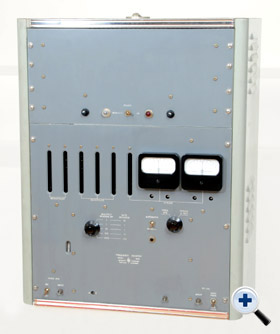 |
The HP 524A |
A fellowship grant made to Al Bagley, a young graduate student at Stanford University in 1948, led to the development of HP's frequency counter business. Hewlett and Packard personally asked student Bagley to study the measurement needs of the nuclear physics industry. From that study came requirements for a faster nuclear-pulse-counting technology, that could resolve two nuclear events, only 0.1 microsecond apart. Bagley determined that new, low-capacitance semiconductor diodes, just coming on the market might allow faster digital circuitry. He built a prototype as part of his project--and then asked for a job at HP.
Out of that work, came the HP 520A high speed decimal scaler, which was able to condition very short nuclear pulses, occurring at up to 10 MHz. It also divided down the count rate by factors of 10 or 100. Sadly, the 520A had only minimal commercial success. However, Hewlett envisioned a different measurement process, one that gated those scaled-down, high-speed pulses into a slower-speed accumulator (counter). It used a selectable time base, similar to that of the earlier WWII HP 100A time standard. Out of this combination was born the common frequency counter.
Those "combination" frequency counters were a huge commercial success, and in great demand from the 1950's onward. They were used in measuring everything from transmitter frequencies to the accelerometers on which ballistic missile guidance systems were based. HP became the industry leader in electronic counting, in the early 1950's, with the HP 524A frequency counter (ca. 1952), which boasted a 0.01 cps to 10 "mc" measuring range. (Hertz came a little later.)
In 1954, plug-in down-converters were added and introduced as the HP 524B electronic counter, which became an industry standard for some years. Plug-ins eventually measured to 18 GHz, after the introduction of the step-recovery-junction diode. Over the years, this product line generated massive revenues and profits, which funded untold numbers of new products.
My own introduction to the HP 524A, came in 1952, when I was out on Eniwetok Atoll, in the South Pacific. We were working on full-scale atom bomb testing, installing blast line instrumentation, which characterized the atmospheric blast effects. Eniwetok Atoll was about 30 miles across, with maybe 20 coral "islands" around the outside circle. It was the result of an old volcano, which rose out of the ocean bottom eons ago, and produced a beautiful blue lagoon in the center, and a surrounding string of islands, built mostly of coral. Think of the atoll as a clock, with the shot island at the 12 o'clock position, and our task force civilian housing headquarters at 5 o'clock, while the military task force which supported everything, and including the "airport," was at 7 o'clock.
This "Mike" shot, on "Operation Ivy" was the first full-scale test of the fusion technology. This H-bomb was predicted to be 4 megatons of energy, and feature a fireball 4 miles in diameter. Needless to say, the instrumentation was housed in heavy-weight concrete bunkers, with a blast line running from the islands at 1 o'clock to 5 o'clock. We had set up about 9 bunkers in all, although the blast was so large that all 10,000 people in the task force were evacuated to ships, which stood off at least 40 miles to the south of the shot island on the day of the shot. By the way, I was intrigued to find a lot of historical information about this test, and many more, on the Internet. Just Google Operation Ivy.
The electromagnetic effects of atomic weapons were fierce, so timing and communication and power cables laid between islands were useless, and the instrument shelters were totally self-contained. In our case, we used about 100 auto batteries, in a separate ventilated battery room, which powered electric motor/generator converters, to get 115 volts. Therefore, we needed to install a highly accurate time standard into each shelter. This required that two days before the shot, two of us, in an Army helicopter, loaded an HP 524A aboard, and started a day-long excursion up the chain. At each island, we would carry that monster instrument through the sand, and into the bunker, let the counter warm up, and make a frequency check. Back through the sand, and onward. Needless to say, that was an exhausting day.
For a kid just out of college, arriving at an operation of such scale was a bit unnerving. My first trip up to the shot island was on a Navy M-boat (a WWII landing craft capable of holding one large 6x6 truck). I saw a 7-story building, which housed the "device." It technically wasn't a bomb, since it required 7 truck trailers of cryogenic refrigeration equipment to make it go. Built out of one side, and going for 2 miles to the East, across a man-made causeway, was a 10 x 10 foot wide tunnel, built of waterproof plywood, and housing plastic bags of helium for the entire 2 miles.
The reason for this test setup was that the physicists needed to measure the time sequence of the buildup of certain atomic particles, which emerged from the reaction. But they needed to put the measuring equipment far enough away, so they weren't destroyed by the fireball, before the measurement was done (in microseconds). The helium allowed the particles to travel the 2-mile distance, more or less freely, without much air attenuation.
As it was, the bunker housing the particle counters was unique. It was divided into 10-foot wide parallel instrument rooms, with an open window facing the bomb, and some the helium tunnel. Huge thick blast doors, in front of the windows, started swinging downward at just the right time so the particles would pass through just as the door clanged down. Even so, with the fireball and huge air overpressures moving fast, serious damage was done inside those compartmented instrument rooms, especially one whose blast door failed to drop. But they got the data, downstairs in the recorder room, where there were Tektronix 530 scopes lined up shoulder to shoulder, for high speed transient photography.
For the instrumentation I worked on, our worst experience with instrumentation was with some Ampex tape recorders. We used these as data backups to photographic galvanometer multi-channel recorders, made by Consolidated Electrodynamics Co. The worry was that prompt radiation might over-expose the photographic film, while the Ampex magnetic tape would not be affected. The shelters were extremely humid, partly because the concrete was still curing, and partly from the acids in the battery room.
We did notice that, when we ran tape recorders every day, occasionally a tape take-up reel brake would stick, but it would soon break free. We should have paid more attention, because when we were taken onboard the ship, there was a 2-day delay before the shot. The asbestos brake linings of the Ampex recorders corroded to the ordinary steel of the brake drums, and about half the tape recorders didn't ever move tape. Luckily, the photographic paper didn't darken very much, so we got all our data.
To give an idea of how much those shelters moved, worse than any earthquake, we had ordered Ampex to install vacuum tube clamps to hold the tube bases tightly to the chassis. Unfortunately, the shock was so great that it shook the glass part of the vacuum tubes out of their own plastic base, so the glass part of the tubes were just dangling when we got there. Most of the heavy power transformers were broken off at the feet, and were dangling by their wires.
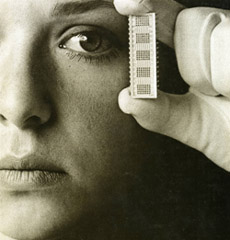 |
This 5-alpha-character cluster used strobing pulses for the display on the HP 9820A, and 9830A Desktop Calculator. Cover of the July 1970 HP Journal, Courtesy of the Hewlett Packard Company |
HP Journal, Feb, 1969, July, 1970
In the mid-1960's, HP Labs was working on various display technologies, since virtually every product HP made, needed numeric or alphanumeric readouts. NIXIE® tubes, built by Burroughs Corp. were expensive, and had reliability problems, and needed high-voltage drive circuits, which were not compatible with semiconductor technology. Nor did their high voltage drives lend themselves to portable use. Worse, the technology was available to everyone, and products tended to look the same.
Egon Loebner had joined HP Associates from RCA, and had brought with him, a lot of knowledge of electro-luminescent technology. It wasn't long before HP had work going on with so-called III-V compounds. These roman numerals designate the valence of the elements, in the periodic table. In particular, a certain mixture of Gallium, Arsenic and Phosphorous atoms could join properly in a crystalline structure, and then be configured into an electrical junction diode. If you could do everything right, the diode emitted visible red light at 655 nanometers wavelength, when forward biased.
By the late 1960's, the HPA division was buying crystalline Gallium-Arsenide in cigar-sized boules, slicing, polishing, and growing epitaxial layers of arsenic-phosphorous on the top. It must be remembered as a true black-magic, arcane art. At that time, I was burning out in Microwave Marketing, and asked John Young, to be on the lookout for a somewhat-more technical job, that might appeal to me, and to be a slower pace. It took about two days.
John proposed that I go down to HPA, to head up the LED display group, since it was struggling for direction. Its process shop was tiny, and needed clear product strategies to set materials and assembly direction. I arrived at HPA, to find a department with about 8 people, two equal-level managers, each with a business card which stated they were the official department manager. Apparently HPA Division Manager Don Smith had brought both down from HP Labs, with the promise that each would manage the group, which was the job I just got.
Within two days, the manufacturing man, Gerry Pighini, had resigned. He wanted to move to Fairchild to be with his poker-playing buddy, John Attalla, whom had just left HP Labs. Within about one week, Division Manager (my boss) Don Smith, himself, resigned to join venture capitalist, Jack Melchor. So I started from there, with my new boss, Dave Weindorf. We had one display product, the HP 7000 numeric display, a 5 x 7 matrix character. Using an on-board integrated circuit chip, it decoded the BCD drive data and provided current for each of 21 (abbreviated from 35) diodes on the face. Each die was 10 x 10 mils.
List price of the 7000 was $35 each. That made them interesting for ultra high-reliability, military applications, but a tough sell for commercial. Yet, we soon landed a surprise contract from the Longines Watch Company, in Switzerland. They bought 1000 sets of 4 digits for a handheld sports timer. That single order of $100K, at a negotiated price of, I believe, $25 each, set us on our way. I believe, in the first year, the department had total sales of $250K.
We immediately began working within HP, to find instrument applications, but the price was impossibly high. So we moved out in three directions,
1) a simpler 4 x 7 dot-matrix character in cheaper plastic package, and with a latching on-board driver IC,
2) a full 5 x 7 dot-matrix with 3 to 5 digits per package, and with external strobing circuitry, that would support full alphanumeric characters, and
3) 1/10th inch monolithic digit clusters of 5 or 7 digits, for miniature digital displays (usually with a simple plastic magnifying lens), ultimately used in the HP 35.
With a lot of missionary work, our product strategy began developing a diversity of applications. The full alphanumeric characters got accepted into the new HP 9820 and 9830 desktop computers from Loveland Division, although the monolithics didn't win in the HP 9810. Instead, Fairchild got that job.
A 4 x 7 dot-matrix modified version of the full-strobed numerics did get chosen for Jim Sorden's HP 5300 family of portable frequency counters. That helped us a lot with engineering refinement of the strobing concept. Joe Diesel and Bob Steward worked the technical applications. Vic Wrooble worked on ceramic materials. Howard Borden ran the engineering, and was a real pro on the esoteric display technology principles.
Howard had worked in the semiconductor industry for some years before coming to HP Labs, and subsequently to our LED group. Interestingly, he fought a lifetime of ultra-sensitivity to certain chemicals used in semiconductor wafer processing. Chemicals like TCE, Tri-Chloro-Ethylene were very common in the industry, and ended up in many toxic plumes underground, which polluted the Bay Area's water supplies.
Our own operation at the intersection of Page Mill Rd and El Camino caused quite a large amount of TCE contamination. The cause was that Palo Alto city code regulations required that the inflammable TCE tanks be put underground, but then they leaked. Our failing was that we didn't have the foresight to install double-walled, leakage detecting tanks. In any event, Howard's super sensitivity remains with him today, even though he has been retired in San Diego for two decades.
One problem with HP applications was the pre-introduction product reviews that each division would hold for Dave and Bill as a final approval meeting. LED's of that day had mono-chromatic light that was SO red that it was at the edge of the visible spectrum. For older people, the tiny red surfaces that emitted light looked blurry, and Hewlett often complained of how uncomfortable it was for him to focus on the numeric displays. Fortunately, he didn't kill the projects, although the same problem surfaced later when the HP 35 calculator was designed.
In the manufacturing area, it was a different story. The process technology necessary to get light out of semiconductor diodes was nasty. Assume it was a process of 32 complicated steps. Slice into wafers, polish, grow epitaxy layers, diffuse zinc, deposit contacts, dice, assemble, etc. And at all steps, clean, clean and re-clean. It may take 4 to 5 weeks for entering material to hit the tester, to find out if you were going to get light.
Grown single-crystal material was purchased from Monsanto and Bell and Howell. In those days, we were happy to get a cigar-shaped boule with a diameter of 1/2 inch. When sawed, you'd get maybe 1/3 square inch of working material. After processing, the outer 20% of each wafer usually wouldn't work, so even though the die were only 0.010 x 0.010 inches, you still wouldn't get many, and for those the brightness was so variable that they had to be measured and selected and matched for brightness so that matrix digits would have even brightness. The human eye is a tremendous brightness error detector.
I can clearly remember the day, probably in late 1970, when we had a coffee-time cake ceremony. On the wall hung a red cardboard sign, which was just 1 square foot. We had calculated that our entire first 1.5 years had been spent manufacturing only that much material area. Some years later, after Ted Larsen's materials people began growing their own Czochralski crystal "boules," or ingots, they turned out a square foot of emitting material every few hours.
Moreover, by the turn of the millennium, there were spectacular technologies which produced red lights, green lights, and yellow lights. They served brake lights in cars, stop lights at street corners, and everywhere a reliable cheap and sun-insensitive light was needed. And now there are "white LED" lights bright enough to serve as flashlight bulbs. Absolutely stunning, when I think of us struggling to figure how to make a somewhat bright far-red LED in 1970, which couldn't be read in sunlight.
A lot of credit for building the massive production capacity for HPA, goes to Bob Zettler, who had moved from HP to Fairchild a few years before, with John Atalla. He returned to HP in 1972 and took over the department after I left. As I mentioned, the reason I had asked John Young for a transfer from Microwave Marketing Manager, was to find a more relaxed pace, and get off the management treadmill. What I found was a terrifically challenging and technologically fun department, but in less than 3 years, we went from 7 people to 105. Another treadmill.
There was also the matter of a totally different personnel culture. HP's instrument culture developed over decades from an almost total dominance over the test and measurement sector of the industry. Thus the environment inside was relaxed and confident, not quite arrogance. There was still stress on project schedules and meeting budgets, but the daily environment was not cut-throat and managers were not sharks.
The semiconductor industry, on the other hand, was total stress. The technology was moving at warp speed, and managers were super-aggressive and difficult personalities. My first introduction to the change I was to face, was a product strategy meeting I attended at HPA, with Milt Liebhaber, the division marketing manager, Dick Soshea, the central R&D manager, Rick Kniss, the product marketing engineer on displays, and several others from my Display Dept. I don't believe that Dave Weindorf, the Division Manager was there.
As I walked in, Milt and Dick were on opposite sides of the table, standing up, and one was pounding his fist on the table, both were yelling at each other. One was smoking a large cigar, and it was what I thought to be a generally disagreeable attitude of the participants. Unfortunately, I was to learn that such behavior was inherited from the semiconductor industry, by way of our hiring people who had previously worked in those aggressive companies. I never got comfortable with those personalities, and that was one reason I moved on after less than 3 years there.
The period around 1970 exhibited a severe economic downturn, and the instrument business was hit like most high-tech companies. The Microwave Division had split, with half moving to Santa Rosa and the remaining group re-named Stanford Park Division. Overlaid onto half the products moving out, the remaining products hit a downturn in sales. In spite of many exciting new products, there were still production employees who had nothing to do. This was the time Bill Hewlett introduced his plan to reduce our production capacity by the simple expedient of taking forced time off every other Friday. Immediately reducing production capacity by 10%.
It wasn't quite enough, and the SPD production managers were looking for places to move some of their people temporarily. Since our LED group was expanding, we agreed to take on a dozen or so instrument assemblers, and make them semi-conductor assemblers. These are people who work all day looking through a microscope, manipulating ultra-tiny parts with tweezers and mechanical levers. It is boring, yet intricate, and tedious work. In the semi-conductor world, hundreds of such workers, sit shoulder to shoulder, for 8 hours.
Needless to say, those transplanted microwave employees got tired pretty fast, and yearned to return to SPD, but couldn't until the business turned around about a year later. Then we would go out and hire assemblers from Fairchild, who thought our production habits were easy, and indeed they were. We were somewhere between the slave-like conditions of Fairchild, and the more moderate conditions of instrument assembly.
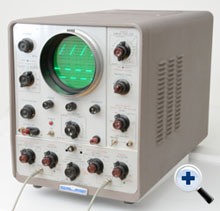 |
The HP 150A |
HP Journal, April, 1956
In the 50's, many of the independent HP Reps carried the Tektronix (Tek) product line along with HP. Tek's oscilloscope products were top of the line, and had built an enviable reputation for superb quality and reliability. The inside product design was a dream, with a special ceramic standoff resistor mounting strips and carefully dressed wiring harnesses.
Tek made a decision around that time to take their product sales "direct" meaning no reps. They began on one coast by writing letters of resignation from their business contracts, which were typically a 30-day notice by either party. In the case of HP, and the world-wide sales representatives, we understood that most of those business relationships were on the basis of a handshake and personal friendship, not a written contract.
One after another, as the rep was cancelled, Tek brought in their own people to set up a sales organization. Well, the loss of a general-purpose product line like scopes was serious matter to the HP reps. They prevailed on Dave to agree to design a line of oscilloscopes to compete with Tek. And thereby began decades of frustrating competition. The first two products were a good news-bad news situation. The HP 130A was a slick dc to 300 kHz low-frequency scope that filled a niche that Tek didn't occupy at that time.
But the product that was meant to take Tek head on was the HP 150A. It was a plug-in modular design with dc to 10 MHz, dual channel, which at that time was deemed general-purpose. To avoid a me-too verdict, HP designers chose to use a bottom drawer plug-in which made the plug-ins non-compatible with the Tek design. Some innovations on the CRT made it easier on the eyes. There was a clever "beam-finder" button, which alleviated the nagging problem with the Tek units of losing the trace when overloaded.
But the poor HP 150 suffered the worst reliability problems. First off, even if perfect, customers would have trouble believing that anyone, even HP could measure up to Tek. They were like Gods. The Tek salesmen had all been trained to be scope repairmen first, salesmen second. Tek President Howard Vollum believed that each and every FE must be able to align a scope and most carried small screwdrivers to tweak the amplifier frequency response of a bench unit as they talked with customers.
It took some years for the HP 150 to become more reliable. Meantime, HP was making more innovations as time went on, such as internal graticules on the CRT. This feature was made possible by the decision to build a CRT manufacturing facility in Colorado Springs when the factory moved out there in about 1960.
In the oscilloscope business, HP was the interloper. Tektronix was a major force in the instrument scopes ever since Howard Vollum conceived of a fast, triggered scope just after WWII. Their product design was superior, a soft brushed, and chemically-treated front panel, ultra-clean layouts of control knobs, and an interior layout of components that was clean enough to qualify for an industrial design prize. Before the advent of printed circuit boards, and the cost efficiency they allowed, most wiring was done with hookup wire, hand soldered to vacuum tube sockets, and wires which traveled to insulated spacers which held the circuit components like resistors and capacitors, etc.
In HP products, the spaced component boards were called Kingman cards, named after an HP mechanical tooling engineer, named Rufe Kingman. It was not an unthought-of irony that his first name was similar to Rube Goldberg. He was the comic character who invented complex kluges which had to go through 15 steps of rolling ball bearings and trip levers in order to light a cigarette. The Kingman machine punched holes in a phenolic board, sheared off a short strip of tin-plated brass, punched it through the board holes, and crimped it, leaving a top slot to receive the component such as a resistor for soldering.
Since Tek was ahead to begin with, and HP was playing catchup, it was a frustrating game. HP pioneered in some low frequency scopes like the HP 120 and 130, which were quite adequate for many jobs, and had real easy readability and features like a simple button "beam-finder," which Tek had never thought of. But soon, they reacted with their own competitive versions.
Larry Johnson recalls, "One technology where HP did innovate was in scope storage tubes. Storage tubes had been around (although not at HP) for some time before HP started using them. I do believe that HP made all of its storage tubes. I believe HP's first tubes were made by Don Hammond's guys down in Bldg 1L. The manufacturing boss and middle-level technology brain was Bert Squires, but the top-level brain belonged to Bill Kruger, a short, gray-haired, quiet, easy-going engineer. Later on, in Colorado facility, Allen Smith was the eventual boss."
As it worked out, Tek matched virtually every move HP made in scopes. Customers were willing to wait for Tek to come up with an answer. The frustration of the Oscilloscope Division was great through the years, because although they worked hard and diligently, it was tough to attack the perceived leader. HP, along with a Long Island company called Lumatron, invented sampling scopes and yet were matched a year later by Tek. HP perfected a practical time-domain-reflectometer (TDR) and that was matched soon after, although HP's technology in RF/Microwave ensured that our TDRs were more comprehensive.
At great expense, HP installed a CRT tube production plant at Colorado Springs, to give us quality CRT tube advantages. One result of this capability was that we pioneered display tubes with internal graticules, which provided a highly-improved reading accuracy. But, fighting Tek still remained a very frustrating job for people such as Bill Terry and Hal Edmondson, who had relatively long careers in the HP scope divisions.
There was another product aspect of HP's entry into oscilloscopes. Most scope products of the time were equipped with special bezels surrounding the display. This allowed a special Polaroid camera to be mounted on the front to take permanent pictures of the display waveforms. This was decades before the advent of signal and waveform-capturing computers.
Since HP had its hands full in the first projects to compete with Tek, the decision was made to make our bezels compatible with the Tek scope camera. But there was a corporate pride thing going on, making it hard to recommend a customer buy our scope and go to Tek for the camera he needed. But HP engineering resources were still hard to find for a scope project.
This led Bill Jarvis (scope application engineer) and Cort Van Rensselaer (scope division manager) to set up a small operation in Mountain View to manufacture a compatible camera, which was distributed by HP. At about that time, Bill wanted to leave HP and start his own company, but Cort wished to stay, so they sold their pending patents and inventory to HP.
When HP moved the Oscilloscope Division to Colorado, camera manufacture and design was transferred. There was at least one B camera generation and maybe more. Jarvis used his share of the camera sale proceeds to finance the Wiltron Company startup. Wiltron ultimately became a serious competitor of HP, mostly in the RF and Microwave sectors. Jarvis later sold Wiltron to the Japanese company Anritsu for a reported $160 million dollars. He took his ownership portion and built a high-end winery in the Napa Valley, one characterized by a huge tunnel bored into a mountain.
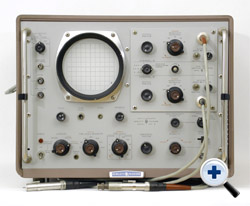 |
The HP 185A |
HP Journal, Jan, 1960
With a market and technology dominated by Tektronix, HP laboratories was always looking for a new unique oscilloscope technology to plant our product flag in the sand. This came with the step-recovery diode technology, and some signal sampling technology which had been used earlier by some nuclear research at the U.S. atomic operations on Long Island. With these, Barney and his lab began an urgent search for a sampling oscilloscope, which could achieve the equivalent frequency response of 500 MHz.
Although Tek had built some very high priced scopes that did the same job, they were brute force, distributed-amplifier designs which were not welcome by customers. Sampling theory is based on repetitive signals such as a continuing pulse train, which is quite typical of test signals to be analyzed. The sampling point of an extremely narrow sampling window is slowly moved along the repetitive test waveform, and by sequentially plotting those points, a continuous waveform results, exactly reproducing the desired test signal.
When the sampling scope was under active development in the Palo Alto labs, the HP Labs was interviewing a manager prospect who worked at Hughes Aircraft Co. Norm Winningstad was a super-star in their display components labs, which were used in their radar system contracts. It was felt that Winningstad would be valuable in the continuing development of HP scope projects like the sampling scope, which was way ahead in technology. So the lab showed him most of the progress of the project to date. For some reason, I was asked to be one of the interview team. We recommended a hire vote, and an offer was made before he left.
Imagine the chagrin of all of us, when we found out shortly that Winningstad had flown further north, after the HP visit, to Tektronix, and was hired there. The worst was to come, for about 6 months later, as we introduced the HP 185A at Wescon, in Los Angeles, that year, we saw that Tektronix had quickly cobbled together their Type N, a sampling plug-in product for their regular 530 series, which purported to perform to the same sampling specs as our much more refined product system. It was disappointing to see a professional use his HP interview as a spy mission, but such is life. Tek never did catch up with HP on sampling technology, and our products continued to advance.
By the way, the HP promotional gimmick for introducing our first 500 MHz sampling oscilloscope at Wescon that year, were 500 MHz "bills" printed to look like paper money, and handed out on the streets outside the conference. This caused a bit of a problem with the show management because so many of the bills were cluttering the streets as litter.
Wescon also saw HP's first use of commercial billboards, which were rented at sites close to the Convention Center, to announce the new HP 8551. Somewhere, there is a picture record of a screwup by the billboard hanging crew, and I think it might be in the possession of Dean Abramson. The picture shows that several panels were hung in the wrong sequence, such that part of the message was spelled, "Anal Spectrumyzer." My old memory is fading but I think I recall seeing that picture.
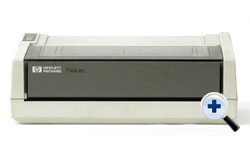 |
The HP ThinkJet Printer |
HP Journal, May, 1985
For some years in the 1980s, Barney set up a practice of holding an annual HP Labs Technology Show, in the Bldg 5M auditorium. This was intended to show the employees just what a diverse and dramatic series of R&D projects were underway in his Labs. It was always exciting to attend and browse through the wide variety of innovative and powerful new products-to-be.
About a year before the ink-jet printer was introduced, HP Labs just showed a technology demo, with a print head driving back and forth, and printing a line of alpha characters. Most of us could hardly believe our eyes, and when told that the engineers had succeeded in blasting millions of tiny droplets of ink out through microscopic holes in a process that happened in microseconds. For us engineers, it was hard to conceive that tiny resistors could be heated fast enough to make tiny droplets of ink explode out of tiny holes at thousands per second. But there it was, writing in front of our eyes.
About a year later, the HP ThinkJet printer was introduced, and as they say in the press, the rest is history. HP's dominance of the printing technology is still held today. And, whether we intended it or not, we got ourselves into the "razor blade" business. You recall that selling consumables like razor blades can be so profitable that you can afford to give away the razor for the revenue you get on a constant stream of sales of razor blades. HP's revenues, which come from the ink cartridges, is not ever revealed separately in their financial reports. I do recall being told by someone, before I retired, that HP ships an amount of ink (in cartridges) annually, which would fill 7 railroad tank cars. I feel quite sure it is much higher these years.
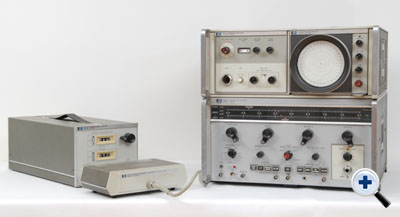 |
The HP 8410A |
The HP 8410A Network Analyzer product line of 1968 ushered in a revolution in RF & Microwave component design and test. Multi-band sweeps of Smith Chart characterizations of components and systems arrived at just the right time for exploiting the hybrid microcircuit technology for instruments and communications systems. Paul Ely had coined the product slogan, "Stamp Out Slotted Lines," and the project became an industrial legend.
There was a confluence of technologies in the late 1960's, which resulted in the HP 8410. The step-recovery diode (see below) gave HP a unique sampling technique, and resulted in the powerful HP 185/87 sampling scope. Then the sampling technique was used in a dual-channel RF voltmeter, the HP 8405A, which also measured the phase angle between the two RF signals. This gave RF circuit designers considerable insight into circuits they were extending up to 1000 MHz.
HP then popularized some "homebuilt" reflectometers with dual-directional couplers, which gave customers the ability to measure signal reflections including their phase angle, using the HP 8405A to 1 GHz. But you still had to plot the Smith Charts by hand from the data. When that technique began to catch on, we knew the HP 8410 was on the right track. Meantime, the HP 8708A frequency synchronizer, which disciplined the HP 608F, taught us how to do signal phase-locking to 500 MHz.
Then came the ability to create phase-lock loops, using sampling diodes to lock quiet VHF local oscillators to track sweeping microwave test signals. And the same sampling diodes were employed to be the dual-downconverters of the HP 8410, yielding a two-channel super-heterodyne receiver which could measure complex impedance to 12.4 first and later 18 GHz. Combining amplitude and phase into Smith Chart type displays gave powerful insight into microwave component design and production. And the signal separation boxes with dual couplers put it all into a nice comprehensive package that truly did, "stamp out slotted lines."
HP continued to dominate the vector network analyzer category for decades, with lower-frequency range as well as higher-capability products. The HP 8753A vector analyzer (ca. 1987) covered up to 3 GHz. Sometimes called the HP 8510's little brother, it was the first low-cost VNA operating below 3 GHz. This positioned it perfectly for cellular design and test engineers working in the 800-900 MHz, and later 2400 MHz range. It was also the first RF analyzer to have complete built-in error-correction.
Along with the flashy VECTOR network analyzers mentioned, there was another important (and more numerous) category of SCALAR network analyzers. Scalar network analyzers measured SWR (standing-wave-ratio) and reflection coefficient, as well as transmission parameters. These were all scalar parameters, but entirely adequate for production line quality assurance.
The first implementation of scalar analyzers was the reflectometer technique that HP pioneered in 1954. Using back-to-back waveguide directional couplers, and a motor-swept klystron HP 670A signal source, with an HP 416A audio ratio meter, waveguide components could be tested at all frequencies across their band. They were developed for waveguide bands from 2.6 to 40 GHz, and for most coaxial bands.
Next came the HP 890-series sweep oscillators which exploited backward-wave-oscillators (BWOs) for signal generation, making the sweep electronic. This led to oscilloscope displays with calibrations grease-penciled onto the CRT screen, not a very aesthetic solution. The HP 1416A SWR display (ca. 1966) solved that with a scope plug-in that provided calibrated & direct reading reflection and transmission data.
Other families of sweep oscillators followed, with the HP 8690-series and finally the HP 8620A-series (ca. 1970) which featured solid-state YIG oscillator sources for the first time. HP's microwave component research labs contributed exceptional results in the Yttrium-iron-garnet technology coupled with microwave transistors to yield exceptionally stable and high-power sources.
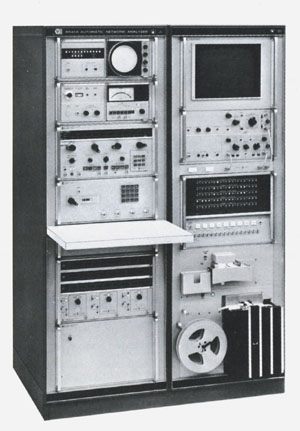 |
The HP 8540A |
HP 1968 Catalog
The great-grandfather of Agilent's 8510C Microwave Network Analyzer was the HP 8540A Automatic Network Analyzer, which was a two-cabinet system introduced in about 1968. It was the HP 2100A computer programming the HP 8410 and several of its plug-ins, the microwave sweeper signals and the transducer signal-separation boxes. It included complete operating software for data acquisition and manipulation. Actually, the first 8540A system only had a teletype for the human interface. The HP 8542A which followed was more refined, with a real CRT display and better software.
Both systems had fortuitous timing, since microwave microcircuit-on-sapphire technology was booming (and blooming) and commercial communication satellite technologies were emerging from the Russian Sputnik surprise of 1957, and the U.S. response of their Apollo moon-shot program.
It can be easily argued that satellite technologies have revolutionized the world's scientific and business accomplishments. Weather satellites provide not just tomorrow's meteorology predictions on the evening news, but give crucial warning of gathering hurricane dangers; mapping satellites sense agricultural and mineral conditions on the earth's surface. The Global Positioning System (GPS) determines navigational position anywhere on earth within 20 feet; and maritime and military satellites provide powerful command and control of our defense establishment. The Hubble astronomical telescope searches for the beginning of our cosmos and the Big Bang.
In the late 1960's, I was flying home from a sales trip to Washington, DC. My flight from Dulles was delayed by one of the jet engines spewing raw fuel onto the tarmac. So, all passengers were removed and sequestered in a metal shed out by the flight line, probably to keep us from finding an alternate flight. I struck up a conversation with a fellow passenger, Harold Rosen, who turned out to be the newly-promoted Division Manager of Hughes Communication Company of Culver City, CA. Hughes had developed an awesome communication satellite payload technology, and was already the recognized leader.
After Rosen found out I was from HP, he revealed that he was carrying home a $69 million dollar contract for the first Comsat communication satellite program. He had just signed the contract with the Comsat Consortium, which consisted of 1/3 U.S. Government participation, and 2/3 from other private communication companies.
In those days, HP employees were permitted to fly first class, if the flight left after normal business hours, so I, as Microwave Division Marketing Manager, had myself ticketed for first class. As we discussed their contract, Rosen noted that he had committed to a penalty clause of $100,000 per day for late launches. It was common knowledge that the inside of their satellites were a rats-nest of dozens of amplifiers, filters, switches, signal processing components, and a maze of cabling, designed for redundancy and reliability. However the bad news was that, if one part failed, at pre-launch test, they would have terrible delays not just to replace the failed part, but re-test everything to assure integrity of all the hundreds of signal path permutations.
The HP 8540A Computer-Network Analyzer System turned out to be a perfect match, even at $200,000 each. It was our first use of the new HP 2116A Instrumentation Computer, which programmed and controlled the signal generators, routing signal switches and network analyzer parts, and collected and corrected all the valuable test data for presentation to the test engineers. And although it was never intended to test satellites, Rosen was highly interested because of his required all-up-around tests on a complete system--especially with his ruinous penalty clauses.
By this time, after a four-hour delay, we got the re-boarding call at midnight. Since I wasn't finished with my sales pitch, I asked Rosen if it would be OK if we talked further on the flight. He said OK. Imagine my surprise when I flopped down in first class, and Rosen walked back into coach class! Carrying a $69 million contract, no less. After takeoff, I asked the stewardess if I could go back to coach, and Rosen and I spent another 2 hours on the jump seat in the rear, where there was an overhead light, to finish with everything I knew.
If I remember correctly, Hughes bought 3 or 5 of those magnificent systems. And, they launched on schedule, a testimony to their engineering prowess. Hughes went on to become a huge merchant supplier for communications systems to countries around the globe, delivering hundreds of flying birds, each with massive capacities of thousands of voice channels. And that HP system never developed any competition. But in its own way, it helped change the world.
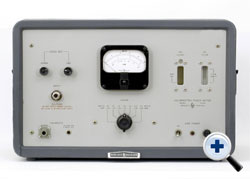 |
The HP 434A |
HP Journal, August, 1958
Power sensors using devices like thermistors were limited to about 10 milliwatts on the top end. The need to measure higher powers was clearly necessary since most radar and communications systems used watts and kilowatts. Sometimes this could be handled with directional couplers or accurately-calibrated attenuators, which would sample perhaps l/l00th of the main line signal. So it was deemed necessary to build a unit capable of directly absorbing 10 watts, which is where the HP 434A came in.
The HP 434A was a miniature plumbers' nightmare. To dissipate the incoming 10 watt signal, a flowing silicone oil stream was envisioned. Further, to provide an insensitivity to temperature changes and outside environments, a balanced arrangement was used. The same oil stream flowed past the microwave resistor that handled dc to 12.4 GHz signals and proceeded to a temperature sensor. Then after a heat exchanger it went on to another termination resistor and temperature sensor, that accepted only a balancing dc power. By supplying the dc power in proportion to the unbalance in two temp-sensors in a single oil path, a measurement of the dc power equaled the microwave power.
It worked great and the dc substitution made it quite accurate. It had little drift, which was a considerable problem on the previous HP 430/478 power bridge thermistor technology. The idea of measuring medium power directly without resort to couplers or pads appealed to engineers. The product was a commercial success.
Enter the USAF. These were the years of the fear-the-Russians mode. The U.S. was busy building BMEWS, Ballistic Missile Early Warning System, three massive radars in the Arctic, pointed north and looking for inbound missiles coming over the North Pole. RCA was prime contractor and GE was building the radars. These monsters had antennas the size of a football field tilted up on its side. The radar transmitters themselves, I believe, were 25 Megawatts.
Everything was full military specification design. Including the power monitor system they conceived to monitor the radar system power on a 24 hour basis. For this, they obviously needed a power meter which wouldn't drift, because obviously they couldn't shut down the radar to balance the sensor. The HP 434A was the choice.
The problem; although the commercial HP 434A unit was highly reliable, one reason was that the pump that moved the silicone oil in its path was an ingenious arrangement that didn't depend on a shaft and seal into the oil compartment. Instead it used a magnetically-coupled impeller, operating through a ultra-thin brass shim. The silicone oil path was completely sealed in, no oil leakage.
Well, in the infernal wisdom of the military procurement, GE was told to insist on a "military specification" motor. This in turn required an organic seal on a rotating shaft of a "military specification" pump. The seal and the nasty silicone oil weren't all that compatible. And we looked for future problems. But it met the mil-spec. Confirming that fact, the front panel was specially designed with a golden-colored alodyned aluminum sheet, that was 24-inches wide, and 1/2 inch thick to meet expected shocks to be caused by presumed nuclear blasts outside.
Now, flash to years later. At a trade show, I met an RCA field engineer who had spent some years of his life on a BMEWS station site at Farthingdale Moor in the UK, working on maintenance for the radars. He described the site. The radar transmitters themselves looked like the generator room of Hoover Dam, in a structure as long as a football field. Rows and rows of radar cabinets, high-power ancillary equipment, and rows of instrumentation. And about 15 of the HP 434s sprinkled throughout the floor, some operational, some hot-standby units.
He said he'd be standing on a catwalk, and begin to hear a faint piercing squeal from somewhere on the floor. It would begin a resonance that began to drive the cabinet sheet metal into a resonance. And the offender was the HP pump seal. They would track down the bad unit and with a little oil can full of lubricating oil hit the organic seal and be ready for several hundred hours more of quiet.
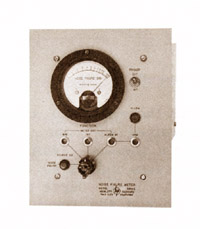 |
The HP 344A |
In the early 60's, Bell Telephone (BTL), in their military equipment division at Whippany, NJ, had contracted for an enormous task. They were to build the acquisition radar and the site radar for Nike Zeus, a perimeter defensive missile that was to be placed around hundreds of U.S. cities for defense against the terminal phase of inbound nuclear missiles from Russia. I believe that the ultimate deployment was to be 50,000 missile units and radars. With a project of this scope, operator automation was crucial, and BTL envisioned using an automatic noise figure meter to monitor the radar receiver sensitivity performance, while in full operation. In radar receivers, one important measure of receiver performance is a parameter called noise figure, essentially an indication of whether it was losing its sensitivity to find targets among noise and clutter. Several years before, we had introduced the HP 340A and then B for commercial applications of making NF measurements. It was built with vacuum tubes.
With the possibility for landing such a whopping contract, New Jersey Field Engineer Bob MacVeety prevailed on Microwave Division Manager Bruce Wholey to develop a transistor version of the HP 340B. The HP 340B, being a vacuum tube model, was not suitable for long-term unattended operation that Bell Labs envisioned. And with the bait of 50,000 units in the future, we were beginning to talk of a future need to build the Bob MacVeety "Memorial Noise Figure Building." Actually, that was some time before Building 5 was contemplated on the Stanford hill site, but would indeed have been Bldg 5.
Well, the upshot was that HP decided to design the new transistorized unit on the basis of an order for about 50 units. And as it turned out, that is all the orders that ever came from that deal. Nike Zeus went away as political administrations changed and politics made such defense systems to be deployed in populous areas extremely unpopular.
The good news was that the engineering efforts needed to design this transistorized instrument became a terrific learning experience for a whole team of excellent engineers. Marco Negrete, Nick Kuhn, and Phil Spohn were all engineers who cut their technical teeth on this difficult design project. All went on to greater achievements, and designed significant new reliable transistor designs, although most of that early transistor technology was built on germanium, and some re-learning was needed when silicon took over later.
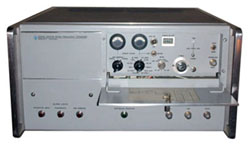 |
The HP 5060A |
In the post-WWII world of the 1950's, the business and scientific community immediately set to work to commercially exploit many of the scientific breakthroughs which came from wartime developments. And one of the sectors of greatest promise was the area of communications, including everything from wireline to cable multiplex to tactical and mobile technologies, short-wave channels and microwave line-of-sight links. Satellite technologies were waiting just off stage.
The basis of most communication links, which consist of a transmitter and a receiver, is that the transmitted signal containing the modulation and intelligence must be highly stable and in close synchronization with the receiver. (In the receiver, this synchronizer is called the local oscillator.) The most popular way of accomplishing this "signal lock" during that era was to generate the transmitter and receiver signals, and discipline them with quartz crystal oscillators. When properly fabricated, quartz has the property of providing signals of excellent stability related to the physical properties of the tiny slice of quartz.
As accurate and stable as quartz technology can be, it still had one prime failing. The signal still drifts according to temperature changes and physical conditions and simple aging. One method of re-calibrating those millions of drifting oscillators was to periodically compare the operating systems to several standard signals transmitted by the U.S. National Bureau of Standards (now the National Institute of Standards and Technology) from Boulder, Colorado, on Station WWV. The Bureau's "clock" was in turn referenced to the U.S. Naval Observatory in Washington, DC, which by law was designated as the nation's timekeeper using astronomical readings as their standard.
The Bureau's early clocks were a family of unique, pampered, quartz oscillators, cross-compared and monitored continuously. But as scientific progress in atomic resonance advanced, it was early realized that if oscillators could be synchronized to the atomic resonance of certain elements, they would achieve a fundamental standard from nature. Highly specialized systems were developed at NBS, and put into service as the nation's time standards.
Meantime, Hewlett-Packard concluded that there was a large market for a commercial version of the atomic oscillator, and proceeded with development of the HP 5060A Cesium Beam Standard. It was based on synchronizing to the microwave frequency of one of the atomic resonance lines of the element Cesium. It had been designed to be as compact as any bench instrument, and capable of rough handling and rugged environments, even including an internal battery for mobile operation between the times it could be plugged into ac line power.
Len Cutler was the HP father of atomic time standards at HP's Time & Frequency Division, which later became the Santa Clara Division. While he was a world-class intellect and highly productive inventor, Len would also win an award for "The R&D Lab's Nicest Guy." He always made himself available to answer questions from marketing and customers.
The proof was demonstrated in 1964, with a well-publicized experiment, whereby two HP engineers flew from the U.S. Naval Observatory to the official world timekeeping laboratory in Neuchatel, Switzerland. They configured two "flying clocks" and purchased first-class tickets in an international airline, making sure that suitable sustaining power was available from airplane power supplies.
HP soon became the world's timekeeper, with a continuing line of industry-leading atomic standards. Today, Agilent's cesium clocks provide 80 percent of the weighting of Universal Coordinated Time (UTC), and virtually define the world's standard second and the stability of the atomic second. For decades, Agilent has led the industry with superior cesium standards which have advanced communications on a broad front. In fact, it can be immodestly argued that without Agilent cesium products, most of the world communications would stop cold, including our wireless communications of the 21 st century.
Satellite technology is particularly indebted to stable frequency. For example, as a moonshot rocket leaves earth, navigational systems count wavelengths of the disappearing transmitter to measure its distance from earth. All scientific satellites require precision frequency control to achieve their objectives.
On earth, frequency synchronization of the international communications networks and the Internet system are based on lightwave and fiberoptic technology, and have at their heart, Agilent Cesium standards. Broadcast television and cable systems are likewise synchronized with Agilent standards. Even cellular communications and the thousands of base stations at the center of each cell need long-term stability and reference to cesium standards. Military tactical and strategic systems, with their massive information transfers depend on Agilent cesium products. And most of the world's metrology laboratories which keep time and frequency for their companies and national standard laboratories are running on Agilent cesium standards.
If there was ever a single Agilent product with world impact, many would nominate our decades-long love affair with cesium. It's nice to have a unique product and one which customers love. Sadly around 2005, Agilent management decided to sell off the time standards product line.
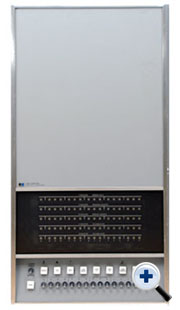 |
The HP 2116 |
HP Journal, Mar, 1967
Some things happen by serendipity. Sometimes faint visions assist in design or business decisions. I believe that the HP 2116A came about that way. Certainly the IBM mainframe business was rolling along in the mid-60's. Instruments were getting digital, typified by the HP 3440A digital voltmeter, and its sales had taken off. Data logging was only as sophisticated as the HP 560 or 561 printer that displayed the readings of our frequency counters.
Comes a visit from a man at a company in Atlanta, who was working on a mini-computer concept. It was probably Dave Packard who realized that there was going to be an intersection of computer control and data processing functions that could leverage the power of instrumentation. In 20/20 hindsight, it seems simple, but my guess is that the alternative at the time would have been to use data logging instruments and relay programmers for sequencing the control of instrument functions. Indeed, military test systems used that very technology, paper tape sequencers for control and paper tape punches for recording the data.
The HP 2116A brought computed measurement and control right down to the engineer's test bench. The so-called "minicomputer's" design strategy was to provide an accessible card cage on the bottom deck of the product, which allowed individual programmable instruments to be connected to the computer. Each interface card controlled one instrument, either stimulus instruments like signal generators or dc power supplies, or measurement instruments such as fast DVMs, counters or spectrum analyzers.
From the year-2006 perspective, these automatic test systems seem primitive indeed, boasting of a human interface which tolerated a clacking teletype with punched paper tape. The original HP 2116A had a memory made using ferrite core technology, with a basic memory size of 4096 16-bit words (expandable to 8K, at $1 dollar per byte.) Storage disks came along a little later, and finally it was modernized with monitor terminals using CRTs.
The real contribution of the HP 2116A was that it was designed so that it didn't need to be coddled, as were most business computers of the time, which existed in temperature-controlled rooms. It was designed specifically for the hostile environmental regime of the factory floor.
The 2116 was extended upward into service as a moderate-priced time-share server, at a time when the General Electric company had created a very user-friendly software application called BASIC. This was quickly accepted by the software-writing professionals, and adopted by the academic community, and ultimately by industry. HP saw immediate applications for BASIC for use in instrument drivers, and appropriate instrument commands were invented to program such instruments.
That system became the HP 2000 Time Share System. But the general explosion of HP's time share revenues was so high it misled our marketing people into thinking that that business was going to go on forever.
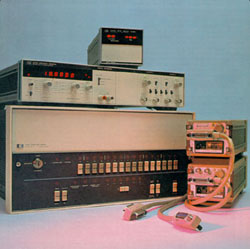 |
Early HP-IB compatible instruments and controling computer |
HP Journal, Jan, 1975
The high cost of HP's powerful mini-computer instrument systems were not available to the ordinary engineer, many of whom still needed such automatic measurement capabilities. It was the confluence of programmable desktop calculators (circa 1972) such as the HP 9810/20/30 and a team of creative brains, which changed things for the better for thousands of HP customers.
George Stanley related to me the history of the beginnings of HP-IB. "In the early 70's Bob Brunner attended an internal HP R&D conference at the Broadmoor Hotel in Colorado Springs, CO. At this conference, Bob said it would be very valuable if HP could find a good way to connect instruments to small desktop calculator/ computers like the HP 9820 and the new HP 9830. Some limited BCD interconnections were considered not robust enough."
"Dave Ricci, SCD, took the job of working it out for high speed instruments like counters and Jerry Nelson, LID, did the same for slow instruments like voltmeters (ac voltmeters took only a few readings/sec). This is how the three wire handshake came about, with a technology allowing the speed to self-adjust to the bus speed of the slowest ACTIVE player in the system. Don Loughry concentrated on the industry standards side of things, and I developed the marketing/ training plan. Of course all our work overlapped, but Ricci is the owner of the three-wire handshake."
The team's vision was to develop a system approach to programming and controlling many of HP's individual instuments such as signal generators, signal measurement products and some unique switching matrixes. The concept was a "party-line" communication bus, which interfaced with some added control and data circuitry inside each candidate HP-IB instrument.
By developing the system in conjunction with an IEEE/Industry committee, this "open system" created a powerful design capability for applications ranging from research and development to production and support and even field test systems.
The attractiveness of the system depended in good part on the fact that instruments from many manufacturers with HP-IB functionality could be "daisy-chained" together. This permitted ordinary engineers to assemble stimulus signals and measurement products such as voltmeters, analyzers and others. The bus strategy included bus protocols such as handshake and other signal functions along with the data transfer. The resulting data could be conditioned, corrected, manipulated, analyzed or stored.
As the IEEE-488 standard achieved wide global acceptance, it became known as the General Purpose Interface Bus (GPIB). The functionality was designed into most new medium-complexity instruments. It exists to this day, even as much more powerful desktop computers came into being, and even though many of the newest instruments contain their own powerful computational microprocessors, they are still linkable by the GPIB. This permits customers to automate production testing and accumulate test data centrally.
George attended Dave Ricci's retirement party at HP Labs in 2004, because he had something to give Dave. It was an old, actual Washington State license plate that read HP-IB, originally displayed by the HP-IB field specialist in Washington. It was given to George at his retirement, several years before, because of his involvement with HP-IB. But he always felt that Dave was much more entitled to it. Here is George's citation to Dave:
". . . . .I'm not sure everyone here understands the significance of what Dave did when he came up with the three-wire handshake for HP-IB. Very briefly, we had slow instruments like AC voltmeters from Loveland that took 1-2 readings/sec. Then we had Bagley's high-speed counters from Santa Clara that took 1 thousand or more readings/sec.
"If we had gone with the clocked bus we first considered, we would have been frozen in at the slower rate and could not have changed upward as electronics speeded up with ICs. and better circuitry. Ricci's flexible speed, three-wire handshake allowed the bus to run at the speed of the slowest ACTIVE device and slow instruments could be easily kept off the bus until they were needed by simple programming and then turned on to do their thing. This is why Dave holds the patent on the three-wire handshake." As George described Dave's contribution, MC Tom Saponas's head was doing an up and down 'yes.'
In later years, a simpler communication bus was introduced, called the HP-IL, or HP Interface Link. It utilized a simpler bus structure. Both served different customer needs.
Discontinued before introduction
Bill Hewlett was an internationalist at the same time he was a creative scientist and engineer. It was Bill's vision that put HP into international sales operations. In HP's early years, the company depended on use of international sales representatives in various key countries. Later, on several of his early trips to establish company-owned sales entities in the important countries of Europe, Bill had purchased the patents and manufacturing rights to several instrumentation products.
One such product was the Sintef Recorder. Earlier, HP had acquired itself into the strip chart recorder business with the purchase of Sanborn Company of Waltham, MA. Although primarily a medical equipment manufacturer (electrocardiographs), Sanborn's chart recorders had found crucial applications in the booming aerospace industry of the late 1950's, in the telemetry instrumentation applications.
These racks full of recorders and signal conditioning amplifiers were used by the hundreds to monitor mechanical parameters of rockets during live firing tests for vibration and stress and strain measurements. The technology was "pen recorders," which relied on styluses that fed liquid ink out to the tip and produced a clean recorded trace, except that flutter and high frequency oscillations hitting a stylus often would fling ink everywhere, and contaminate the clean multi-trace records.
The Sintef recorder promised to expand that market with a novel ability to plot 10 channels of data, across a 10-inch-wide chart, with a linearity of 0.1%. The bad news was that the technology that was used consisted of a stainless steel band (loop), mounted on two 6-inch diameter spinning wheels, and moving at 100 miles per hour. It looked very much like a shop bandsaw turned on its side. The band itself contained three tiny nibs (needle points) spaced evenly along the band, which contacted the slowly-moving chart paper, which was moving perpendicular to the speeding band.
Ten electronic comparators computed the position of a plotting point (nib) across the chart, and when a given channel required a plotted dot, it triggered a 2000-volt pulse, which burned a tiny, black hole in the white chart paper surface, which had a conducting carbon film on the backside. With 10 channels, that meant each nib plotted 10 points as it raced crosswise across the paper. Each pass happened in 10 msec, so that it could respond to step functions far faster than previous pen recorders. And the linearity was superb.
The Sintef recorder had been the design responsibilty of the HP Labs, and unfortunately had not had the benefit of any marketing insight to determine the sales potential based on its product feature set. In the case of products designed by the central R&D lab, once such a product is brought to a manufacturing level, it was handed off to a product division, for manufacture and marketing. In this case, the most likely division was Microwave, headquartered right there in Palo Alto, which was also the home of the HP Labs.
After the original Microwave Division was established in 1962, and since its fabrication shops in Palo Alto had exceptional mechanical capabilities, a magnetic tape recorder product group had been formed under the management of Walter Selsted. Walt was a senior engineer and manager who had worked under the original Ampex founder, Alexander Poniatoff. He had recently left Ampex, and had been hired personally by Bill Hewlett. The objective, most likely, was to put HP into the high-tech tape recorder system business.
The first HP Labs demonstration of the bandsaw recorder was held for the MWD management, Division Manager John Young, Engineering Manager Paul Ely, Manufacturing Manager John Doyle, and myself. It was a real eye-opener, in more ways than one, and a real test for the sense of smell. As the recorder sat there, plotting 10 channels of slowly moving data, there was an objectionable fizzzz--whizzz--zzzzz sound, and 10 little fuzz balls of fire at each plotting point, drifted across the page. Added to the sound, an acrid ball of smoke rose from the machine.
A far worse defect, we found out later, was that, since the plotting was done with 2000-volt pulses, and the backside of the paper was carbon, the plotting paper coming out the front of the machine acted like a radio antenna, emitting serious RFI, (radio frequency interference). We also learned that 10 of the prototypes had been built, and that $500,000 had been invested so far, with another $150,000 to go. Plus Hewlett's original cost for buying the patent in Sweden.
Back at the division, John Young's immediate private reaction was, "We have got to kill that turkey, and not spend another dollar on it." So he wrote a masterful memo to Bill Hewlett, accepting the product into the Microwave Division, pointing out that we would need to do some marketing study. He noted that at the moment, our MW lab was busy with other products, it might take a bit of time to re-initiate the recorder project.
In marketing, I took several of the prototypes and sent them on the road with several of our application engineers. The marketing reports coming back were incredibly negative, as we expected. The noisy sounds, the smoke, and the RFI were just the beginning. It turned out that because it plotted dots, and not continuous lines, it often happened that a fast changing data line would become discontinuous because no dots were plotted for a vertical transition distance. And the "lines" themselves were plotted with fuzzy dots, not the pleasant lines made with ink pens.
The only positive response came from Woods Hole Oceanographic Institute near Boston. They needed multi-channel capability, and had slow moving data, encountered by plotting ocean bottom data. The RFI didn't bother them--since they worked in steel rooms of a research ship--and the smoke was handled by simply opening the door to open air.
The upshot of the market research was that John Young determined to simply kill the project, by means of just shelving it permanently. I made the decision to donate the 10 prototypes to the Woods Hole organization, for their marine research. Which leads to the final fatal flaw of the product. It turns out that the spinning bandsaw nibs moving across recording paper at 100 mph were worn out in less than 10 hours, caused by the fact that any paper is tremendously abrasive. The engineers had tried everything, sapphire, diamonds, carbide, and the hardest of materials. Nothing worked. If the bandsaw nibs wore out every 10 hours, and had to be replaced manually, this fact alone would doom a product which was intended to record long-term (days and weeks) worth of data.
The way we managed that flaw with Woods Hole was that we agreed to donate the tooling apparatus which manufactured the bandsaw band and the plotting nibs. Since they were at sea for weeks at a stretch with an on-board machine shop, it caused no problems.
There are two "the rest of the story" elements to this doomed project. The R&D project manager was Dick Hackborn, who later rose to become HP's Executive Vice President, and a super successful manager of the HP computer and printer operations. He has always received the highest praise for his considerable vision in the product strategies of those arenas. On one occasion, in a management interview, he inferred that his marketing success had come from his insistence on comprehensive marketing and customer insights, before any product was approved for R&D and manufacturing investments.
He admitted that such insistence had, in some way, come from a long-past marketing failure, without mentioning any further details. It is quite ironic that HP's economic gain from Hackborn's powerful management skills at the head of a massive printer operations were gained from a failure to invest some modest marketing study before taking the bandsaw recorder that far into pre-production.
The second element was that some 10 years after we donated the instruments to Woods Hole Oceanographic station, I attended a trade show in Boston. One of the show goers with a Woods Hole badge came into our booth. I recounted the story about the recorders, which were installed on their research boat. Amazingly, the visitor had actually worked for many years on that very research vessel, and reported, "We love those recorders, and are still using them."
"Any problem with the RFI and smoke or wearing out the bands," I asked? "No problem, for RFI, we work in STEEL rooms. Smoke? We leave the door open. We love those instruments, but of course have to make all our own spare bands. But, we have a full machine shop on board, and the machinists often have nothing but time, so we have plenty of bands. Since a lot of our work involves slowly moving functions of multiple channels, such as ocean bottom profiles, they work out perfectly."
So, here was a remarkable case of serendipity, and a hidden contribution to ocean technology.
Bob DeVries told me that the recorder might have been shown in one IEEE show in New York on a private hotel suite demonstration for key customers. It was never revealed to me at the time that customers had seen the finished product.
There is another footnote here, since there were a few other failed-products that Bill and Dave considered, and spent some time developing, during those earliest years. Dave mentions several of them in his book. So the HP 300A was not truly the second HP product. We learned about these other products over time, sometimes when old field engineers would gather to reminisce.
One such product was the lettuce thinner, an attempt to automate a tedious farm job, done by hand, where a farm laborer had to walk down rows of growing lettuce, and thin out the crop for optimum growth. HP figured that by using electric photocells, that a mechanized tool could be mounted on a tractor, and do the job more uniformly, and for less cost. I believe that the photocell sensor was the bad performer because it was not constant in its profiling of the various shades of color of lettuce. In the story I heard, Dave laughed that it tore out as much good crop as it left standing.
They also attempted to use the electric photocell as a proximity indicator for the flushing mechanism for men's urinals. I don't remember any description of the reason for not carrying this product into marketing trials, but I think we can guess. It seems to have taken about 50 years for the micro-miniaturization and integrated circuits to make this process feasible, so now they are installed in many commercial establishments. HP's idea was decades ahead of its time, except those ancient photocell components just weren't up to the task. And they weren't low voltage.
Finally, HP actually did design and build a product that was a spot-welding timer. It was based on digital counter technology, since it was possible to digitally set the time needed for spot welding processes, using decade counters. Although forgotten for decades, sometime in the 1960's, when the independent Canadian Sales Company was bought out, and replaced with HP personnel, HP also bought all their assets. One of the assets found abandoned in a warehouse somewhere in Canada, was an actual HP welding timer. I suspect that it ended up in the HP corporate archive and museum.
HP Journal, June, 1971
It's hard to believe in these times of billion dollar product winners, that there were times at HP where we actually looked for what we predicted would be $1 million dollar (annually) winners. So, during the late 60's, we were looking outside the aerospace and high-tech business for ideas for use of our microwave technologies to solve some problems. One of these came up as "molecular rotational spectroscopy." At a molecular level, microwave energy interacts with the slow end-over-end rotation of chemical molecules. So, this HP microwave machine worked on the principle that the molecules of certain low pressure vapors and gases will absorb minute microwave energy at specific frequencies, related to the chemical characteristics of the gas molecules.
By sweeping the frequency inside a sampling chamber called a "Stark Cell," the gas passing through will absorb tiny amounts of the microwave signal. The detection is enhanced by means of pulsing a high-voltage electrode (4000 volts/cm) running down the middle of the cell. This modulates the molecular absorption effect and thereby allows a synchronous detection of the tiny microwave losses in the cell. The resulting swept frequency plot provides a "finger-print" of the various gases, and allows for diagnosis of various chemical reactions.
Howard Harrington was the PhD cheerleader for this chemical analysis project. His enthusiasm never waned, over the many years that HP designed and introduced and sold the product. He was convinced that there was a Nobel Prize hidden somewhere in the chemical analysis performance that was inherent in his machine.
Alas, it never happened, and the product was transferred to the HP Scientific Instrument Division (SID) over on California Avenue, and integrated into their product line. But, unfortunately, the SID gas chromatograph/mass spectrometer system was just beginning to take off dramatically, so the microwave machine just died. Too bad, since it was a powerful analysis tool. And you have to admit, there aren't all that many HP instruments introduced, which have the ultimate potential to generate a Nobel Prize. Although the Nobel Committee never saw it that way.
There are a few generic HP measurement contributions (mostly non-instruments) which cross all lines of technology and products, yet I feel should be recognized.
Al Bagley related this story. "In the early 1960's, F&T engineer Frank Boff was working on harmonic-comb generators to extend the frequency range of our counter frequency down-converters. One circuit was showing non-intuitive results, with high frequency harmonics that were much more powerful than theoretically possible from a non-linear resistive device such as a diode. To investigate further, he borrowed an early lab prototype of the HP sampling scope to display a time-domain picture of what was producing such rich signals in the frequency-domain. When he finally got the fuzzy picture focused, he didn't see the expected chopped-off top of a sine wave, produced by a diode, but instead saw a sine wave that rose smoothly to almost full amplitude, then suddenly crashed to near zero amplitude."
"At that point, serendipity entered. Frank remembered seeing a paper in the IEEE proceedings, which theorized that such a waveform might exist if a device exhibited a non-linear charge-versus-voltage curve instead of the non-linear current-versus-voltage curve that defined a normal diode. Frank reviewed the article, restudied the strange wave-shape, and proclaimed that what he had taken to be a non-linear resistor, or diode, was actually a non-linear capacitor under certain conditions."
"What he had developed was a variation of the well-known P-N diode which enhanced the stored carrier phenomenon, and achieved an abrupt transition from reverse-storage conduction to cutoff. Remarkably, it was able to switch tens of volts or hundreds of milliamperes in less than a nanosecond. The result was the ability to generate milliwatts of harmonic power at 10 GHz from stable oscillators running at 200 MHz. That device, discovered by an extraordinary engineer, was called the "Boff diode" for a number of years. Sadly, the name was later changed to the more-generic "step-recovery-diode," for marketing reasons. Boff is retired back in his home country, the UK."
HP exploited this new power in a wide variety of products, giving us dramatic and proprietary performance for some years. HP counters used the harmonic-comb signals to down-convert test signals for counter coverage to 18 GHz. The HP 8410 network analyzer used a two-channel version to down-convert microwave signals for characterizing scattering parameters to 18 GHz. Sampling oscilloscopes, after prototypes were used to discover the effect, in turn, used the diode to generate large-voltage sampling impulses, of extremely narrow width, for measurement of fast-transition test signals in the pico-second range. A whole generation of HP signal generators and sweepers used the rich harmonics to stabilize microwave signals using the technique of indirect frequency synthesis.
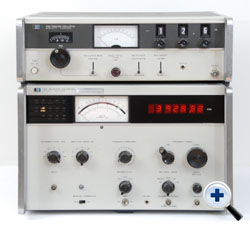 |
The HP 312B and 313A Tracking Generator |
HP also became the world leader in exploiting phase-lock loops for frequency control and phase-disciplining of programmable switched microwave oscillators. Using step-recovery diodes to provide rich harmonics from stable and low-phase-noise LF oscillators, and synthesis techniques such "divide-by-n," sophisticated phase-lock loops were used to discipline MW oscillators and reduce their phase noise. The product features that they provided were exact and programmable output frequencies, of exceptional resolution, and superior phase noise performance.
In an associated application, and certainly an example of Bill Hewlett's "next-bench syndrome," HP innovated a new phase-loop stability measuring technique using the previously-mentioned HP 312A selective voltmeter. With an associated tracking generator that produced a signal equal to and tracking with the tuned frequency of the HP 312A, this combination analyzed the closed loop performance of feedback loops, validating the fast switching response and loop stability under wide environmental performance.
Another variation of the plebian P-N diode was the PIN version, which acted at low frequencies like a regular diode, but at RF/microwave frequencies, it was a programmable microwave resistor. Its construction was simply to insert an intrinsic region of silicon material between the p-region and the n-region. PINs became the centerpoint for broadband control of MW signal amplitudes for power-leveling loops, and as an ultra-fast pulse generator with rise/fall times of nanoseconds.
Edgeline mechanical coaxial switches were conceived as a dc-18 GHz coax SPDT switch, by Dick Anderson and Steve Adam. The original HP 8761 coax switch was a marvel of simplicity, but dramatic in the performance consequences it bestowed on microwave instruments. It was needed in the late 1960's, during the introduction of the HP 8410 network analyzer, for ultra-low-loss signal switching inside the network analyzer signal separation boxes. Switches using semiconductor diodes were far too lossy. In a real sense, those switches became an entire career for Dave Veteran, who engineered the concept into dozens of components, which were smaller, faster, covered millimeter frequencies, etc.
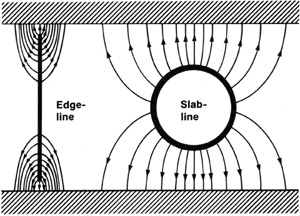 |
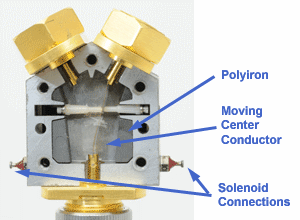 |
EM field configuration (l) permits flexing of thin blade between the parallel planes. Round conductor is used in the HP 805 slotted line |
|
Between two parallel ground planes, 0.218 inches apart, a 0.182 inch wide beryllium-copper blade was suspended edgewise, such that most of its RF field was forced into the narrow (0.018 inch) separation between the blade edges and the ground planes. Thus, the blade could be mechanically flexed parallel to the ground planes without affecting the signal transmission characteristics of the blade at all. The design caused the blade to mechanically flex from one coax output port to another, using solenoids, making a simple SPDT coax switch. Permanent magnets held those positions without applied power, and the programmability feature was a huge plus.
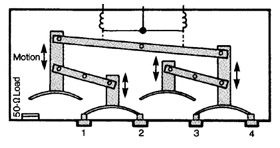 |
The HP 33312 |
The next clever design was a programmable step attenuator, which used two of the switches, to switch each attenuator element, in and out of the transmission path. Thus were born the HP 33330-family of step attenuators, 0-120 dB. Later as the more-compact HP 33320-series attenuators, they were used in all signal generators, spectrum analyzers and sweepers to achieve programmable signal control. Then came the HP 33312-family coax switches, which were smaller, 26 GHz, and boasted 80+ dB isolation and 5-port capability.
I was writing a simple application note (AN-332) about that time, which was intended to cover simple applications considerations for using those simple coax switches. I'm not sure when the concept came to me, but I realized that the HP 33312 four-port switch could be sold to microwave automation customers as a "transfer" switch, which could program an external component, say a filter, into and out of a transmission line. So I wrote that application into the application note.
Then I noticed that those same 4-port switches might be used as the "cross-point" switches in a full-access signal matrix. For example, a 4 x 4 matrix (4 input lines and 4 output lines) would require one HP 33312 at each of the 16 line intersections, actually only 12 altogether. So, I included these simple application extensions in an add-on application note, AN-332-1, so customers could build their own full-access matrixes. Soon, customers were requesting that HP quote on building complete matrixes, and we had ourselves a new market.
Some years after retirement I visited Santa Rosa and learned that those matrix switch products have been extended into super sophisticated switching products which have been worth tens of millions of dollars of revenue over those decades.
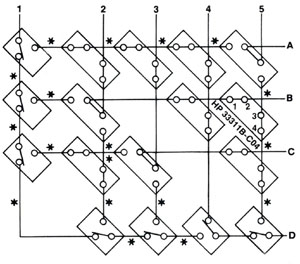 |
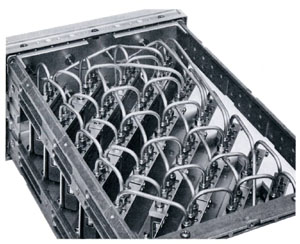 |
80 dB isolation permitted "cross-point" matrix applications |
Full-access 4 x 4 signal matrix |
So, in its own way, this mundane mechanical component idea was perhaps more influential (and profitable) than some of the other glamorous semiconductor breakthroughs of all those decades.
In addition to integrating instruments with the HP-IB, in 1987, HP led a consortium of major instrument manufacturers to devise a modular architecture, the VXI. It relied on previous popularity of the computer-industry-standard VME technology, and initially focused on low frequency and RF. VME was an card cage design, with internal power supply and signal bus interconnections. Conceived for portable applications, including military, custom measuring applications can be configured into standardized modular cages. Dozens of available compatible instrument solutions from multiple suppliers are now available, and software routines can be devised to control the measurement process, many now using the modern plug-&-play concepts of hardware and software.
A similar open standard was introduced for microwave applications, the MMS, modular measurement system. It was built for higher-frequency signal performance with much more attention to electromagnetic compatibility, interference shielding and RF/microwave signal routing.
Finally, while not a product for sale, a mention should be made of a continuing HP performance standard which dramatically affected the ownership experience of all HP customers. This was HP's so-called "Class B" operating environmental qualification.
During its infancy of the WWII years, HP occasionally contracted to design militarized test equipment for the rugged field conditions of the armed services. Usually the customer was an aerospace firm, with contracts that required that their support equipment be fielded into the military environment on shipboard or USAF maintenance hangers on test carts, or into field maintenance huts with the U.S. Army. These operating requirements demanded proper operation in a wide range of thermal and mechanical environments. It was found, not surprisingly, that when those HP militarized instruments were commercialized, their failure rate and field reliability were often superior to many other ordinary designs.
This observation led HP to implement an instrument class of environmental specifications that ALL HP commercial products had to meet. The test designation was called Class B, as compared to full mil-spec designs which were Class A. Class B instruments had to operate without harm, from -40 to +65 degrees Celsius, and perform to published specifications from 0 to +55C. In the design qualification phases, the entire parts list was analyzed, part by part, to determine how much derating of components was to be used. For example, resistors were to run at only 75% of their maximum published power ratings.
Since heat is generally the killer of reliability, infrared scans were made on chassis and printed circuit boards to identify spots of unwanted heat, meaning a component circuit was improperly designed. It is generally accepted that these rigid programs of operating qualifications were responsible for the high esteem that our customers, the world over, held for HP products.